As a horror writer, I’ve always engrossed myself in the horror genre. From an early age, I consumed any, and all media related to horror.
It was more than a decade ago that I first discovered Japanese horror mangaka, Junji Ito.
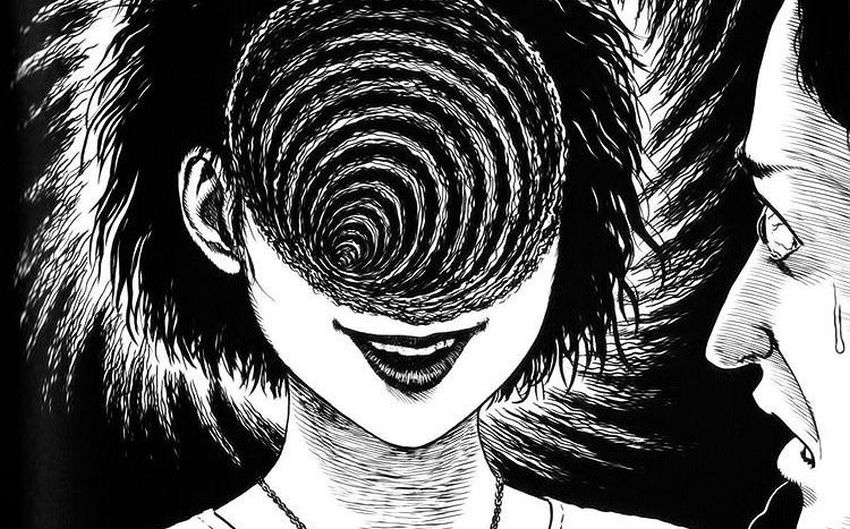
Junji Ito is one of the greatest horror mangaka and one of the greatest horror artists of our time. There’s something special about his work. It’s not simply his style and his dedicated line-work, but also his narrative style that makes his work so original.
Many of his stories feature cosmic horror, distortions of body and mind, phobias, fears, and many other, stranger things. One can easily say that Ito’s works are completely unique and there’s no other mangaka that’s like him in both style and narrative.
Some works such as Uzumaki feature classical Lovecraftian horror. Others like The Bully are more realistic and can best be categorized as psychological horror. Yet some are utterly bizarre and absurd, like Hanging Balloons.
Want to know more about Junji Ito and his work? Check out the Writers Mythos and their episode on Junji Ito which was co-written by me.
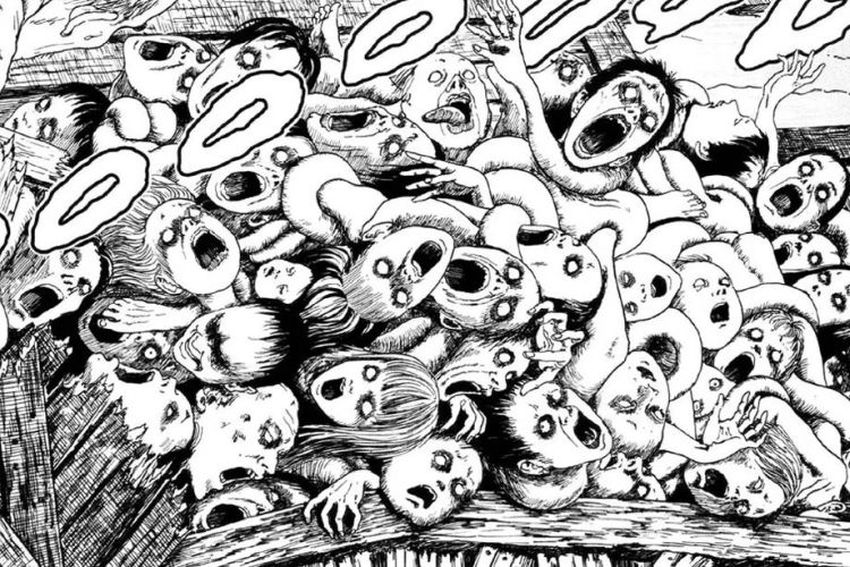
If you’re interested in learning more about those things, and my ideas about it, I wrote a long article about Junji Ito’s style. You can read it here.
It’s often hard to review Ito’s works since his stories don’t rely on twists and plots like other stories. Most of his stories give us a glimpse into a horrible world and let us see the horrible events that happen to his main characters.
I’ll try my best not to spoil the crucial details about his stories, but at times it’s unavoidable. So here’s an obligatory spoiler warning.
As a fan of over a decade, I’ve decided to put together a long list of my favorite works by Junji Ito. Even though this is a long list, it’s still only a fraction of his entire body of work.
So here’s a list of my favorite 40 Junji Ito stories.
Table of Contents
- 40. Slug Girl
- 39. Bronze Statue
- 38. Drifting Spores
- 37. The Blood Sickness of the White Sands Village
- 36. Ice Cream Bus
- 35. Mold
- 34. Scarecrows
- 33. Demon’s Voice
- 32. Rib’s Woman
- 31. Unbearable Maze
- 30. Mimi’s Ghost Stories
- 29. Hellstar Remina
- 28. Flesh Colored Horror
- 27. Den of the Sleep Demon
- 26. Gyo
- 25. The Chill
- 24. The Human Chair
- 23. Dissection Girl
- 22. The Secret of the Haunted Mansion
- 21. The Thing That Drifted Ashore
- 20. The Window Next Door
- 19. Black Paradox
- 18. Glyceride
- 17. Town Without Streets
- 16. The Bully
- 15. The Licking Woman
- 14. Frankenstein
- 13. Tomie
- 12. Oshikiri
- 11. Headless Statues
- 10. Fashion Model
- 9. Lovesick Dead
- 8. Long Dream
- 7. Army of One
- 6. Lingering Farewell
- 5. The Enigma of the Amigara Fault
- 4. Layers of Fear
- 3. My Dear Ancestors
- 2. Uzumaki
- 1. Hanging Balloons
40. Slug Girl
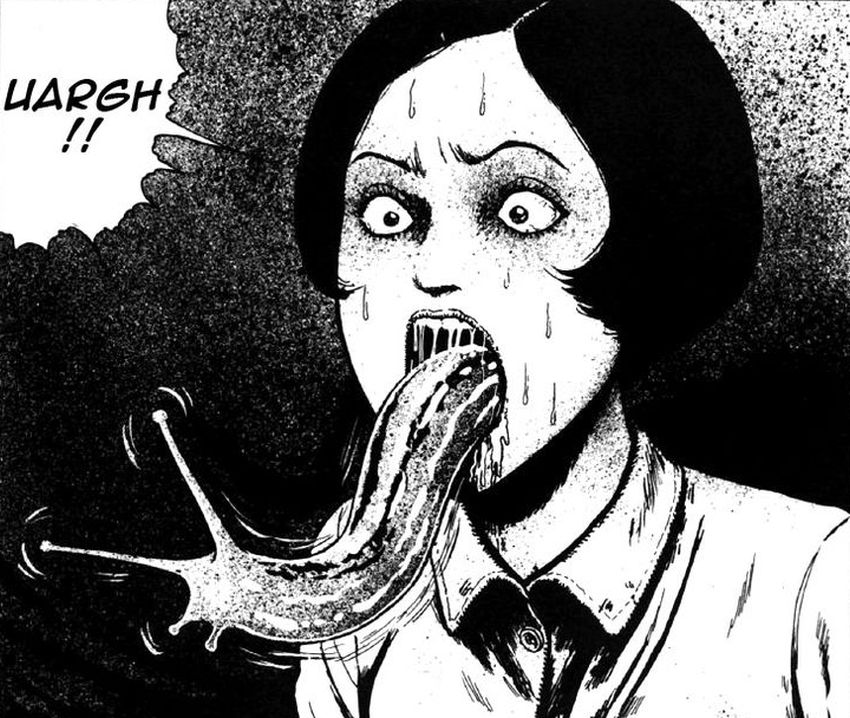
Slug Girl is a very short tale and can be best described as a typical piece of body horror. It’s one of Junji Ito’s most popular tales and has been featured in various other lists and recommendations.
There’s a certain appeal to the story of Slug Girl. It brings everything to the table a typical Junji Ito story needs. It’s bizarre, creepy, disgusting, and the ending is downright sad.
Still, it’s a bit on the short side and I wish the idea’d have been explored more.
Slug Girl tells the story of Yuuko, who suddenly suffers from a swollen tongue. At the same time, her family’s backyard is infested by slugs which her parents try to get rid of.
Yuuko soon starts to feel sick and the true nature of her sickness is discovered.
It’s an outlandish tale that plays with our fears of irrational and strange sicknesses.
39. Bronze Statue
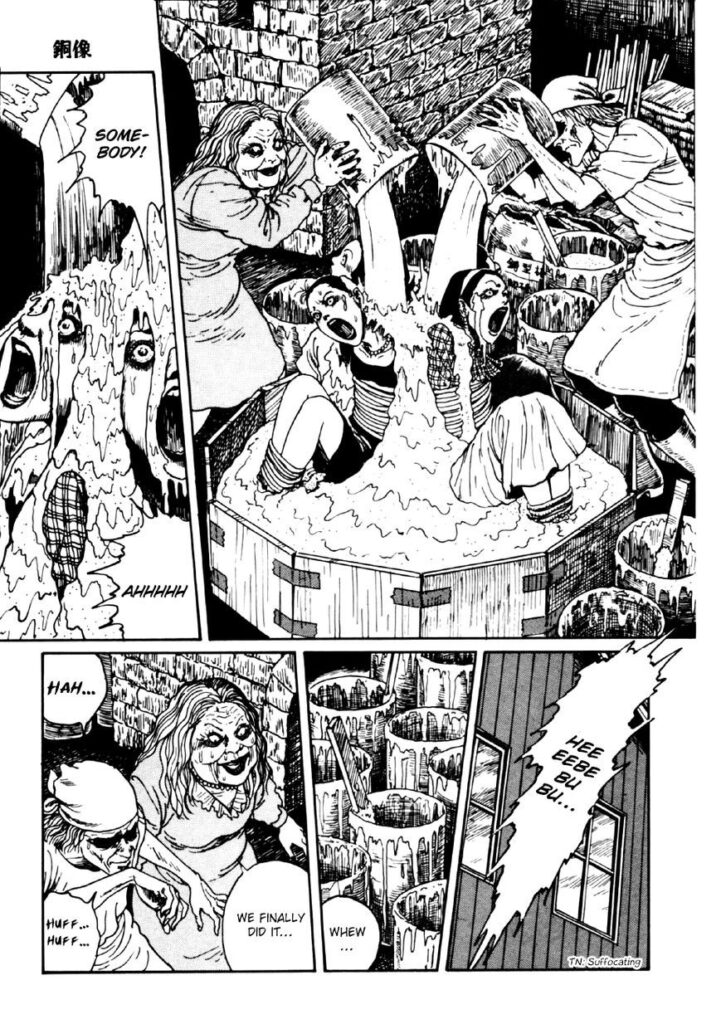
I first read Bronze Statue in its raw, Japanese version and didn’t understand a thing of what was going on in this story by Junji Ito.
What stayed with me was the image of murdering people by encasing them in plaster and later creating statues that showed their demise.
Most of Junji Ito’s stories are brutal and disturbing, many far worse than this, but somehow this image stayed with me.
Once I could actually read the story and understand the plot, it wasn’t one of my favorites. The story centers on vanity, jealousy, and obsession with beauty. It’s still worth a read, if only for the gruesome depiction of murder. The rest though is rather forgettable.
38. Drifting Spores
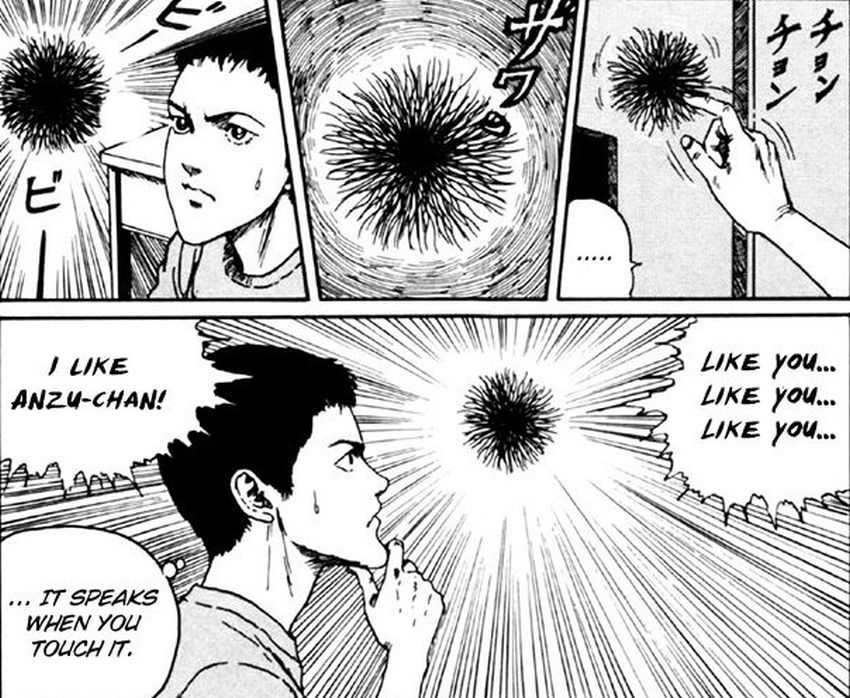
This is another, somewhat weirder story by Junji Ito that I enjoyed quite a bit. It’s one I never really see mentioned by other people or on lists, and I know why. It’s not one of Junji Ito’s typical, horrific tale, but a more somber and thematically heavy one.
In a small town, strange drifting spores appear that can mimic people’s voices and even repeat what they said. Soon enough people collect those spores, not only to hear their voices but also for the spores to reveal their secrets.
The story features such topics as the invasion of privacy and the urge to know the secrets that others keep to themselves. Throughout the story, this urge of some grows to an obsession of one character and ultimately drives him to commit a menacing act. It’s a tale that shows how far we can be driven when we mess with things we don’t understand and which are beyond our control.
It’s a tale that’s not driven by sheer horror or outlandish imagery, but one that shows how far our nature can drive us.
37. The Blood Sickness of the White Sands Village
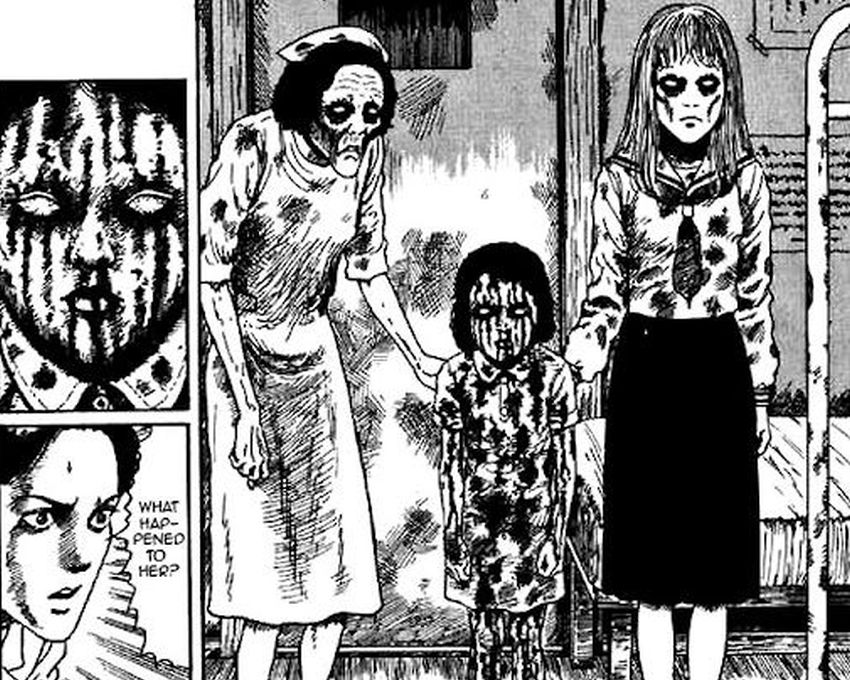
This another underrate Junji Ito tale that I never see mentioned by anyone.
It’s the story of a young doctor named Furahata who moves to a small remote village. The people there look lifeless, gloomy, and withered. They suffer from a strange illness that makes them bleed profoundly at varying intervals.
As Furahata tries to figure out what’s wrong with the villagers, he ultimately learns the cause of the sickness and the terrible nature of the village.
It’s a slower, more Lovecraftian tale that ultimately pays off. I enjoyed this tale, especially since the scenario is like the one featured in my longest-running series A guest at my motel asked me to post his story. He looked like he went through hell… and my upcoming novel.
36. Ice Cream Bus
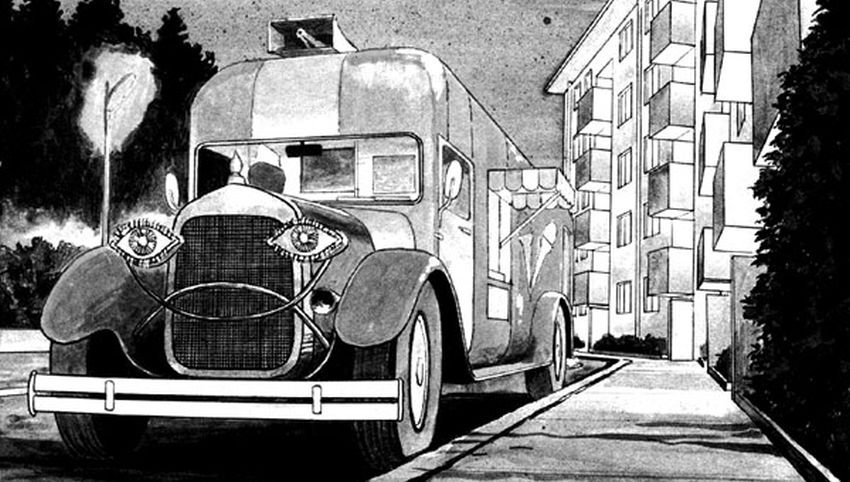
Reading this title, I’m surely not the only one who thinks back to fond childhood memories. Even now I remember the ice cream truck that appeared at my home once a week selling sweat treads and other delights.
Of course, this is a story by Junji Ito and it’s not about reminiscing the good old times.
Each week when the ice cream man appears with his truck, he not only offers the kids ice cream but also a ride around the neighborhood inside his truck. The narrator, a recent divorcee, eventually lets his son join in on the fun.
After a while, the narrator notices that things around the house, around the neighborhood kids and his son get increasingly stickier. Eventually, things come to a horrifying conclusion.
This is not one of Junji Ito’s best tales and the scenario is frankly said, almost comically bizarre. What makes this story special is how Junji Ito twists the mundane and sweet childhood memories into something terrifying. It’s always a delight to experience stories like that.
35. Mold
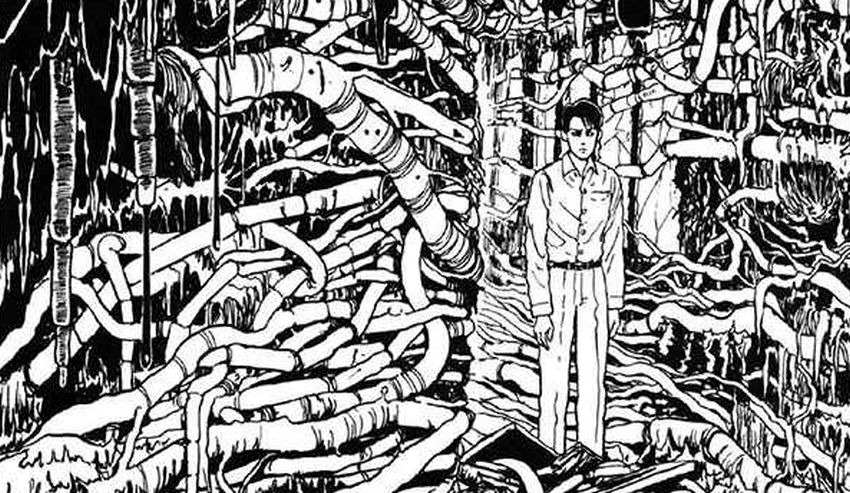
This is one of Junji Ito’s most disgusting stories as you might guess from the title.
The premise is simple. A young man returns to his house after a year abroad, only to find it abandoned by his subtenants. Even worse, they left the house in a disgusting state of destitute, and mold is growing everywhere.
Said subtenant was his old teacher, Mr. Rogi, a man who had a passion for studying fungi.
The narrator tries to clean up his house, but it’s to no avail. The mold keeps spreading further and intensifies, slowly warping the entire house. As the story progresses, the mold grows everywhere, forming giant tubes that pump out disgusting black liquid.
Eventually, the narrator discovers what happened to Mr. Rogi and his family and will most likely suffer a similar fate.
This story is absolute hell for any germophobe. Especially because of Junji Ito’s style, which creates an utterly haunting, rotten hell.
34. Scarecrows
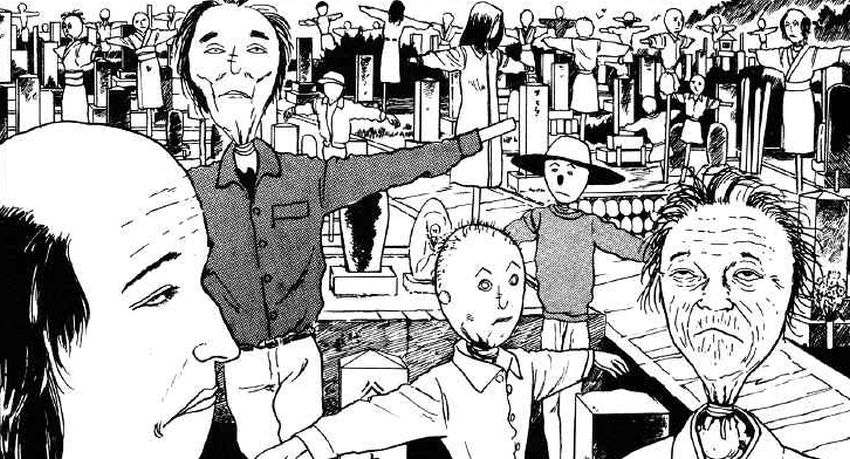
Scarecrows is another story with a simple premise.
The inhabitants of a small town realize that if they plant a scarecrow on the grave of a deceased relative, it will take on their likeness.
Things don’t stop there, and soon mysterious things happen in the graveyard.
While it’s a weird and creative story, it’s also not as outlandish as some of Junji Ito’s other tales. Still, it’s an interesting premise and a worthy read.
33. Demon’s Voice
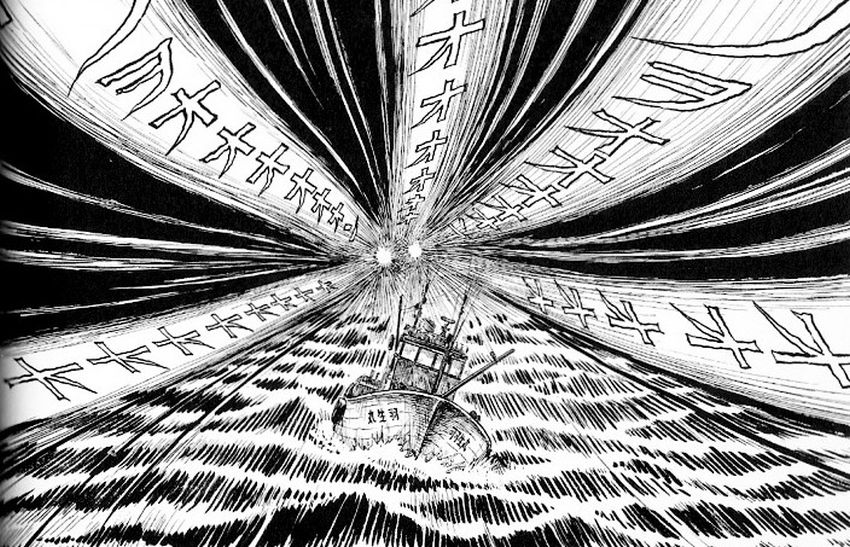
This is Junji Ito’s version of the siren’s call.
There isn’t much to say about this story. It’s about a group of fishermen out at sea who eventually hear the titular demon’s voice.
The next day, after a long dry patch, the crew makes a big catch, but only one member of the crew, not affected by the shrill cry of the demon, sees what they truly pull from the sea.
Demon’s Voice is a delightfully short read with some great and disturbing imagery that’s so typical to Junji Ito.
I enjoy stories that not only incorporate popular tropes but change them up and breathe new life into them. It’s not a beautiful woman that drives the men to their death against the cliffs. No, it’s a demon’s voice that makes them hallucinate and causes them to ultimately suffer their demise.
32. Rib’s Woman
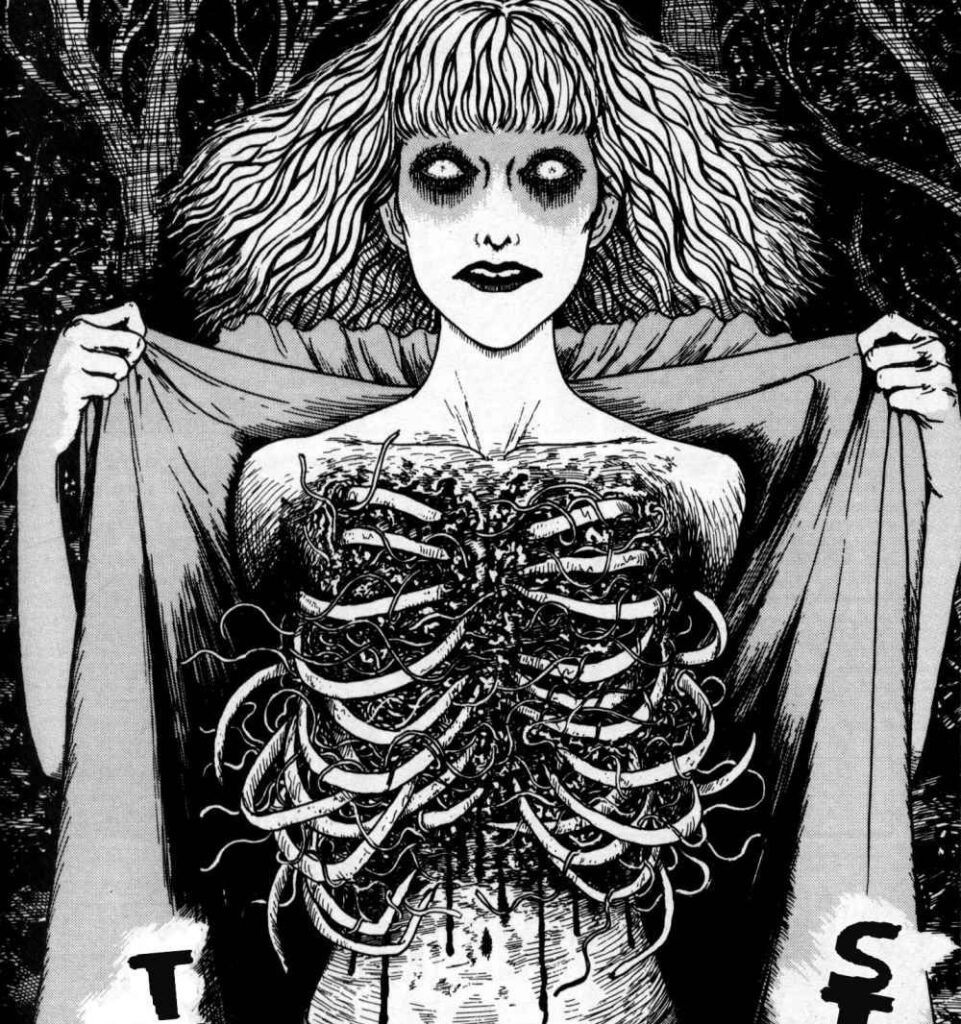
Rib’s woman is a tale that focuses on plastic surgery and body image. One thing I found weird about this tale is the reliance on plastic surgery. Especially considering that the main characters Yuki, as well as Ruriko, are both still in high school.
Rib’s woman is the tale of Yuki, who wants to be pretty and eventually relies on plastic surgery to have some of her ribs removed to get a slender waist.
Soon enough though, her friend Ruriko, who underwent a similar procedure, starts to hear awful music. Eventually, the two of them discover that it’s caused by a mysterious, creepy woman. She’s playing on a strange harp made from bone.
From here on things only get crazier as the true nature of the instrument, and the mysterious woman, are revealed.
The revelation features one of Ito’s most iconic images of body horror that’s become popular on the internet.
The story itself is a bit of a mess, especially the aforementioned aspect of plastic surgery. Yet, the body horror, and the strange nature of the instrument, make up for it.
Rib’s Woman has also, in part, inspired my story called Real Art Always Has a Price.
31. Unbearable Maze
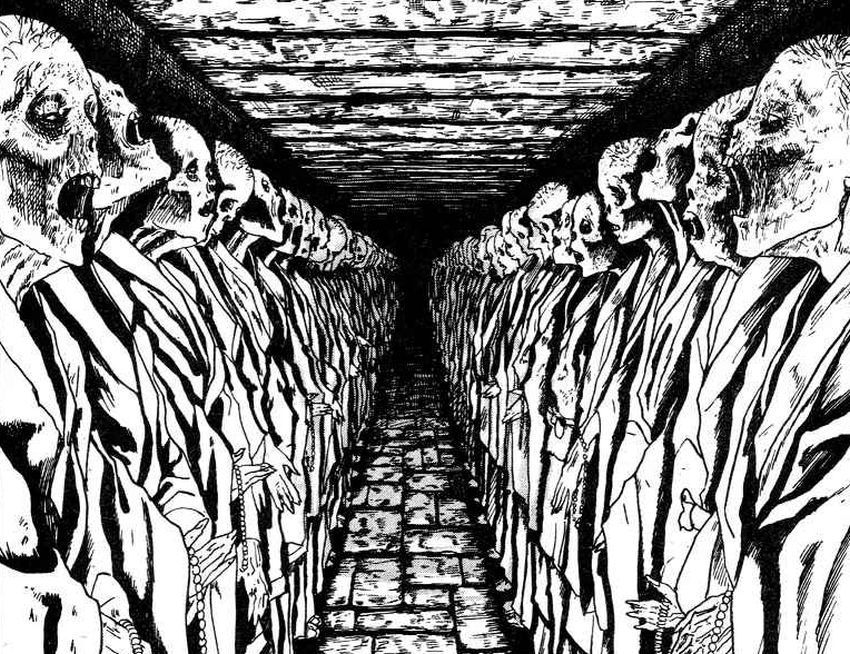
In this story, we get to know a young woman, Sayoko, who goes on a hiking trip with a friend. Sayoko’s friend is worried about her since she hasn’t come to school for a while, for reasons she hasn’t disclosed yet.
The two of them get lost in the mountains and eventually find their way to a monastery.
On a whim, Sayoko stays and joins their healing meditation program. It’s because of her fears and her state of mind.
From another visitor, Sayoko and her friend learn that things aren’t what they seem. The monastery’s members ultimately enter a state of eternal meditation, which means they become Buddhist mummies.
Eventually, Sayoko and her friend end up in the labyrinth which is the final resting place for those members of the monastery. As the two of them get lost, they eventually encounter an area where the members are still alive. Under the gazes of hundreds of monks, Sayoko finally reveals that she’s suffering from a fear of being watched.
This story isn’t too special, both in the premise and execution. What makes it so good, is that Junji Ito’s able to create a scenario in which Sayoko ends up in her personal hell, an endless row of people all staring at her.
30. Mimi’s Ghost Stories
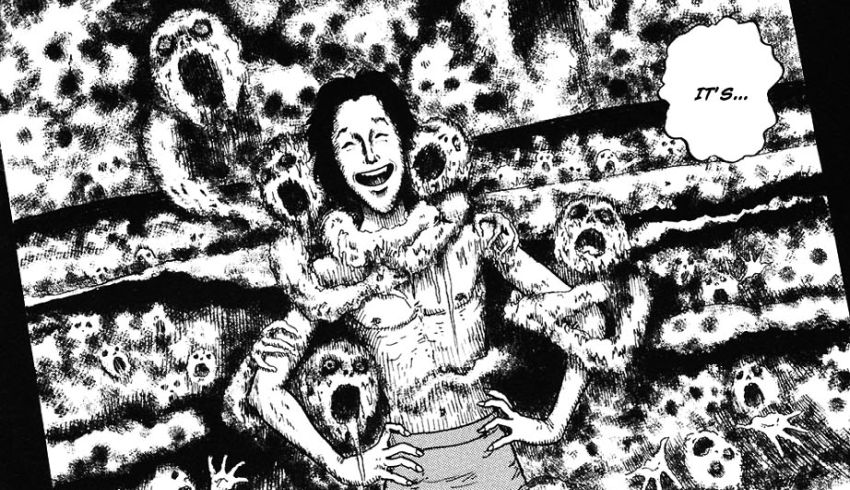
Mimi’s Ghost Stories is a collection of six tales about ghosts which the titular character, Mimi, encounters.
The interesting thing about this collection is that Junji Ito didn’t write the stories, but he merely collected them. All the stories in this collection are all based on Japanese urban legends.
The volume features Junji Ito’s typical style, but to me, none of them stood out particularly. It might because they haven’t been written by Ito himself.
The one I enjoyed the most was the chapter titled ‘The Seashore,’ but even this one felt rather lukewarm compared to Junji Ito’s other works.
Now don’t get me wrong, Mimi’s Ghost Stories is an interesting and enjoyable volume of stories, and I’d highly recommend it to any fan of Junji Ito’s work. However, there are other, better works of his available.
29. Hellstar Remina
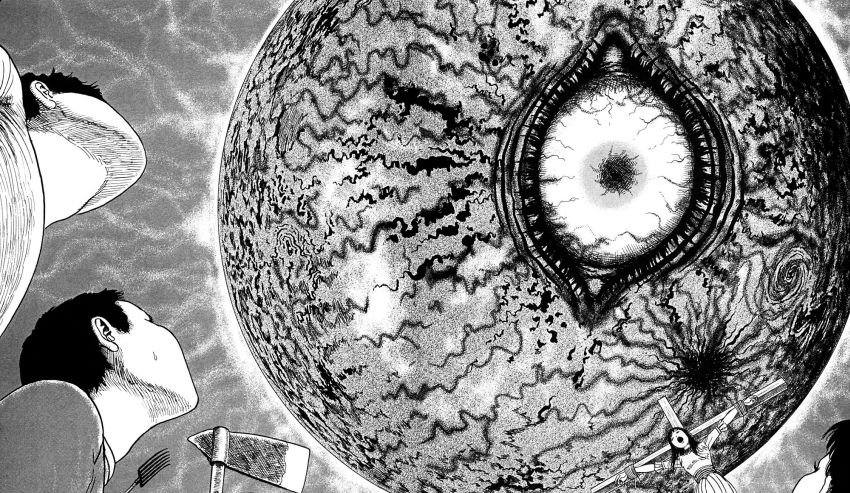
Hellstar Remina is one of Junji Ito’s best example of Lovecraftian cosmic horror.
Professor Oguro discovers first a wormhole and then a new planet that appears to have entered our universe via this wormhole.
He names this newly discovered planet after his daughter, Remina, who’s propelled to stardom because of the event. What’s weird about Planet Remina is that it moves in random directions with no clear orbit. Even stranger, all the stars in its vicinity seem to vanish.
It soon becomes clear that the planet has set its sight on Earth and is closing on it. Soon Remina enters our solar system and one by one all the other planets are destroyed or devoured by Remina.
The story only gets weirder and more insane from this. Unfortunately, Hellstar Remina also becomes sillier the longer it goes on and I had a hard time taking it seriously in later parts.
However, one has to give Junji Ito credit where credits due. An apocalypse caused by a sentient planetary entity is fantastic. It just seems that the story focuses a bit too much on the humanities’ reaction and especially the hunt for the professor’s daughter.
The imagery in this story is fantastic though. It’s a terrifying delight to see Planet Remina with its eyes and mouth. Its surface, as we later see, is as horrifying as its general appearance.
As I said though, the crazy and silly plot made it hard for me to enjoy the later parts of this work. As a Junji Ito fan, it’s still an interesting read, if only for the imagery of the titular Hellstar.
28. Flesh Colored Horror
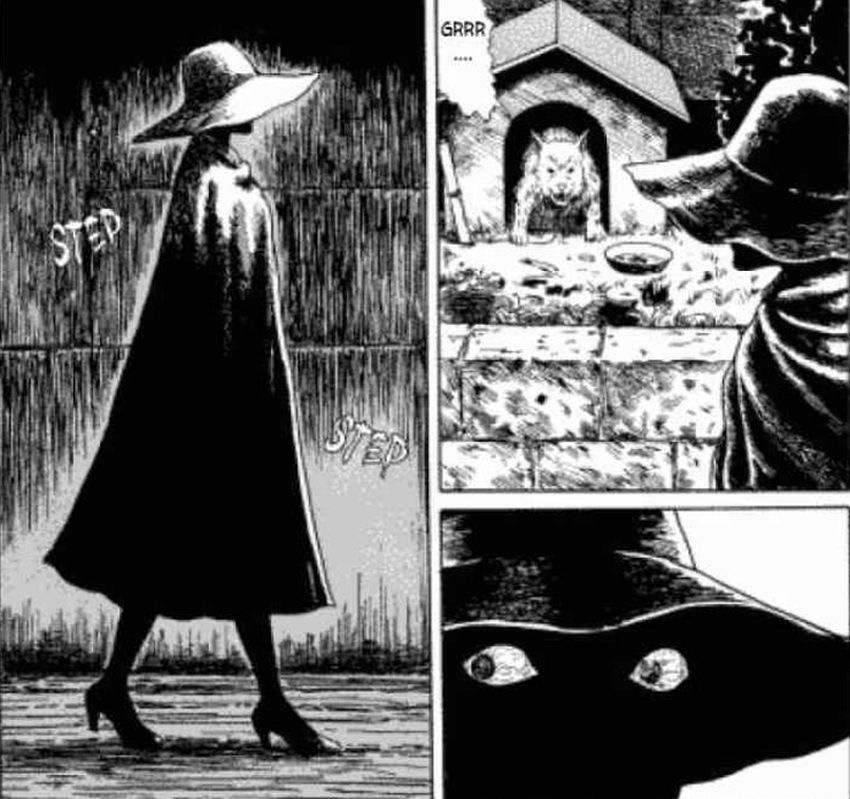
At the beginning of this story, we get to know Miss Takigawa, a kindergarten teacher. One night, on her way home, she’s assaulted by an unknown person and drenched into a strange liquid.
At the kindergarten itself, there are problems too, caused by one of the kids Chikara. He’s a troublemaker and behaves violently towards the other kids.
Eventually, Miss Takigawa visits Chikara’s home only to discover the true horror of this story and the reason for his behavior.
Flesh Colored Horror was another one of the first Junji Ito stories I read, and boy was I in for a surprise. It’s one of those stories that demonstrates how imaginative Junji Ito is and how creative he can get.
27. Den of the Sleep Demon
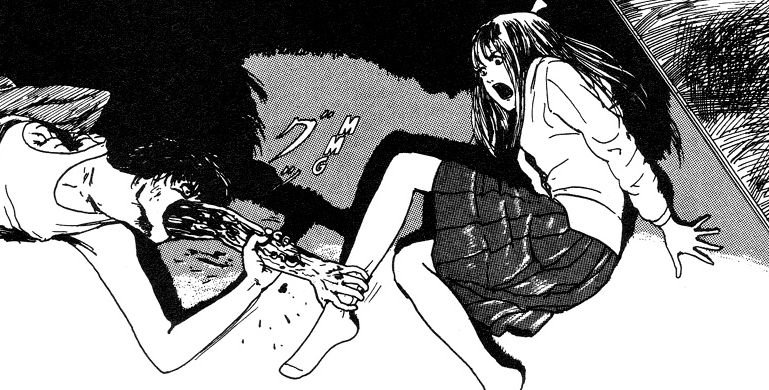
Here we have another typical Junji Ito tale. It’s short, it’s terrifying, and it comes with some very crazy visuals.
The main character Yuji, a young writer, confesses to his girlfriend, Mari, that he hasn’t slept for three days. It’s because of his fear of his dream-self, an entity with the goal to replace Yuji here in the real world. Whenever Yuji falls asleep, he says, his dream-self is coming out.
Mari doesn’t believe him, but is worried and agrees to help him overcome his fears.
Eventually, though, Mari learns that Yuji’s fears aren’t as irrational as she thought.
The most terrifying part of this story is that it throws Yuji into a fight he can’t win. We’ve seen similar scenarios in other media before, and we all know that it’s impossible to stay awake forever.
26. Gyo
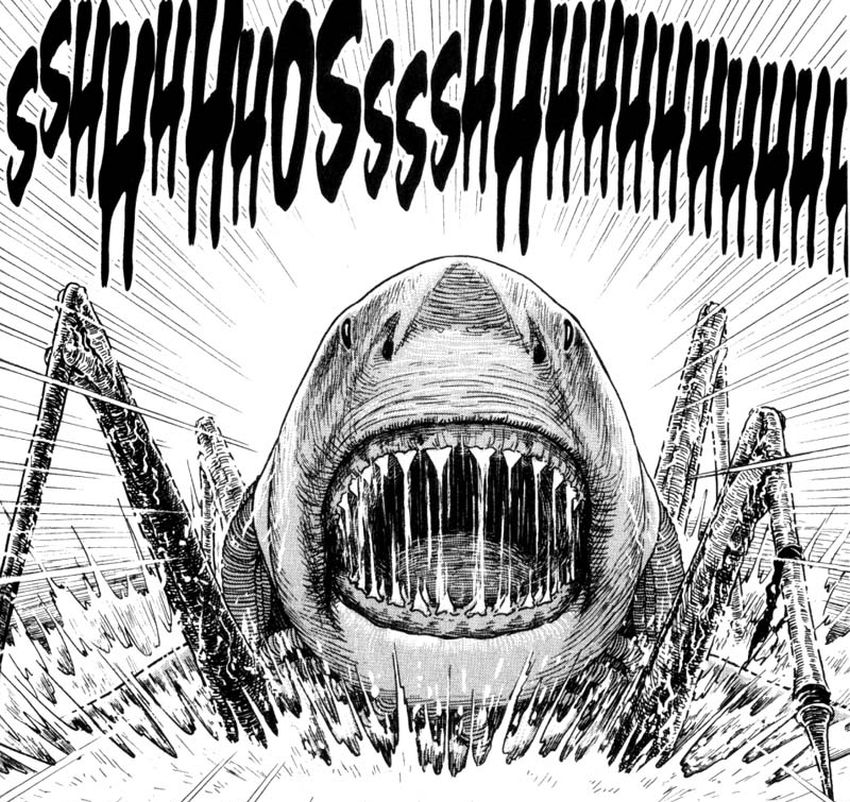
Something stinks.
Gyo means fish in Japan and knowing that you might think you’re prepared for what’s coming. Believe me, if you’ve never heard about this story, you don’t. Gyo is without a doubt one of Junji Ito’s most iconic and popular works.
Yet, it’s also one of his weirdest and most absurd stories.
The premise is simple. Sea-dwelling creatures emerge from the depth and invade the land, but not in the way we’d expect them to.
The story starts with Tadashi and his girlfriend Kaori going on a vacation. Kaori, who’s very sensitive to smells, soon complains about a terrible, rotten stench. Soon the two of them notice a strange fish on robotic legs that’s skittering through their holiday home, spreading the disgusting smell.
While it’s only a tiny fish at first, soon bigger fish, including a giant shark, emerge from the depths.
Back in Tokyo, the story enters full-fledged apocalypse territory as the so-called death-stench spreads, and millions of sea-creatures flood the city and Japan.
Gyo is without a doubt a very creative story. There’s nothing like it out there. What’s interesting here is that Junji Ito combined two common fears. First, the fear of the deep sea and what’s hidden down there, second our fear of the skittering, multi-legged movements of insects. As if this wasn’t enough, he also adds the disgusting, rotten smell known as the death stench.
While I can praise Gyo for its creativity, it also suffers from many problems. The predominant one being that Junji Ito tries to explain what’s going on. Things start absurd, but as the story continues they become ridiculous and finally downright silly. It was hard for me to take any part of Junji Ito’s explanation seriously because it made no sense at all. Horror is often best when it’s unexplained and we don’t uncover the mystery. In Gyo Junji Ito tried and, in my opinion, failed at it.
The strongest part of Gyo is definitely the outlandish imagery, especially in the later parts of the manga when it’s not just fish, but also bloated, disfigured humans walking the streets.
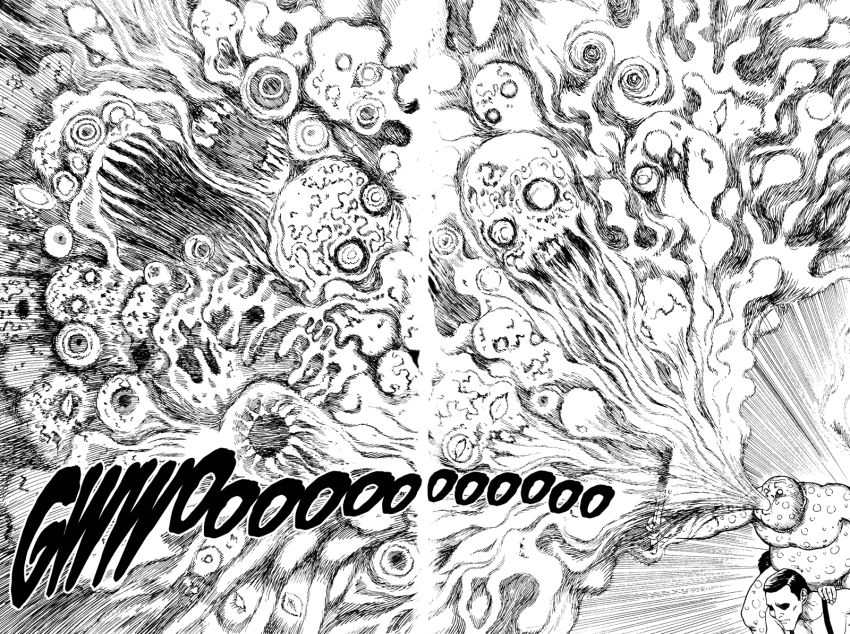
My absolute favorite chapter in Gyo is the one about the circus. It comes completely out of nowhere and features the single greatest page in the entire manga.
For all the criticism I give Gyo here, it’s still an iconic story, and a fun read if one doesn’t look at the story too critically.
25. The Chill
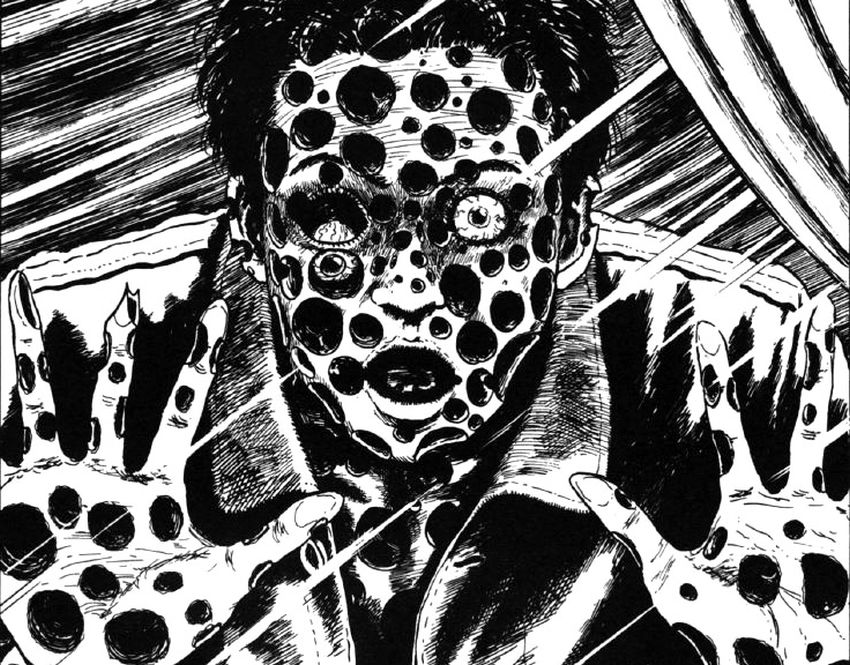
Considering Junji Ito’s interest in phobias, there had to be one that features trypophobia. This is it, and it’s a fabulous story. There’s something about holes appearing all over your body that’s deeply unsettling but also strangely fascinating.
The story starts with Yuuji, who talks about his neighbor Rina, who spends most of her days inside because of a strange illness. Said illness causes holes to appear all over Rina’s arm. When Yuuji sees this he remembers that his grandfather too suffered and died because of a similar illness.
Yuuji tells his best friend Hideo and together the two of them try to uncover what happened. That’s how they learn about a strange jade statue related to it.
This is another one of Ito’s story that talks about man messing with things he doesn’t understand, greed, and obsession. And of course, holes, lots and lots of holes.
24. The Human Chair
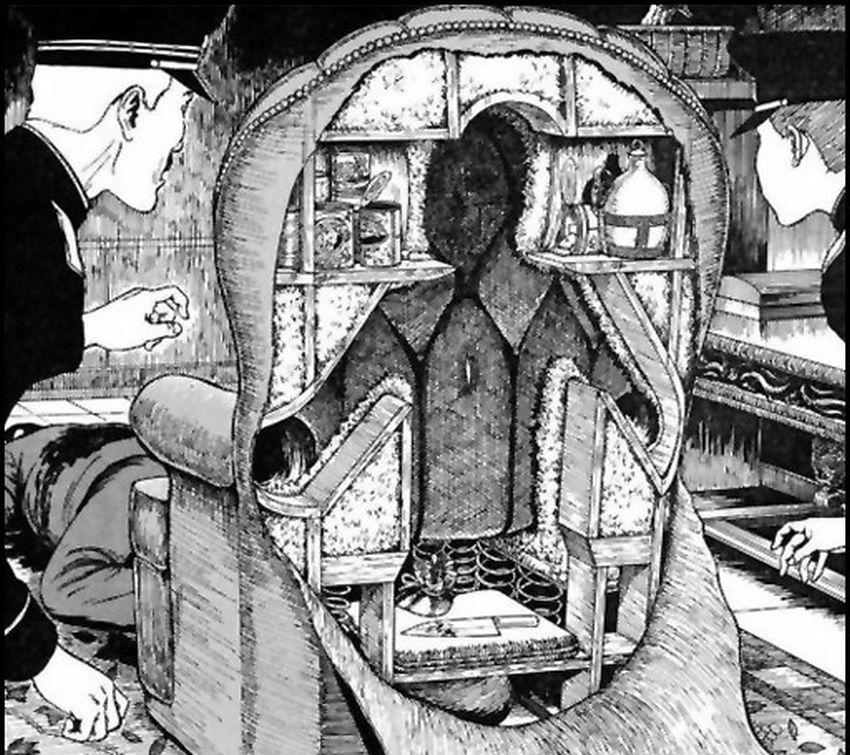
The Human Chair is a story that was originally written by Japanese writer Yoshiko Togawa and adapted as a manga by Junji Ito.
The story features a female writer, named after the author of the original story who receives a letter from a fan. The letter contains a very unsettling manuscript about someone hiding and living inside an armchair.
It’s another of Ito’s most popular stories that I see mentioned a lot. The entire premise of the story is very unsettling and brings forth the topics of privacy and obsession.
What drives this story home is again Ito’s unique art style combined with a truly unsettling idea.
23. Dissection Girl
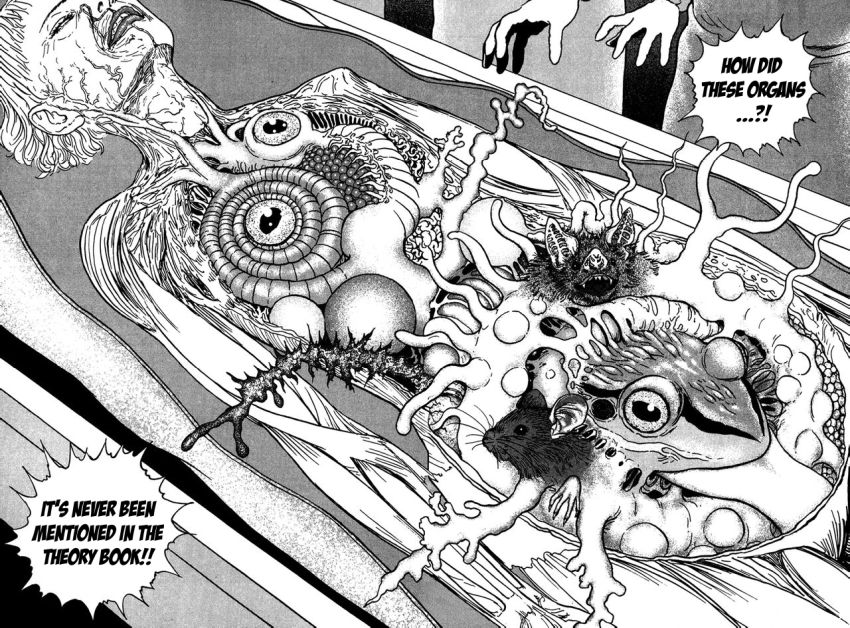
This story is a prime example of Junji Ito’s mastery of the body horror genre, and his artistic skill.
At its core, it’s a story about body dysmorphia, but once again Junji Ito drives it up a notch. It’s not about changing your body, it’s about having your body cut open and being dissected.
Ruriko is a young doctor who’s visited by a mysterious woman who wants him to dissect her. As the story progresses, we learn more about the titular character and the reason for her obsession.
Dissection girl is as typical a Junji Ito story as can be. It features two of his predominant themes, body horror and mental illness.
What makes this one stand out is the disturbing imagery, especially that of the last page. It’s truly one of the most absurd, yet most creative images of body horror I’ve ever seen.
22. The Secret of the Haunted Mansion
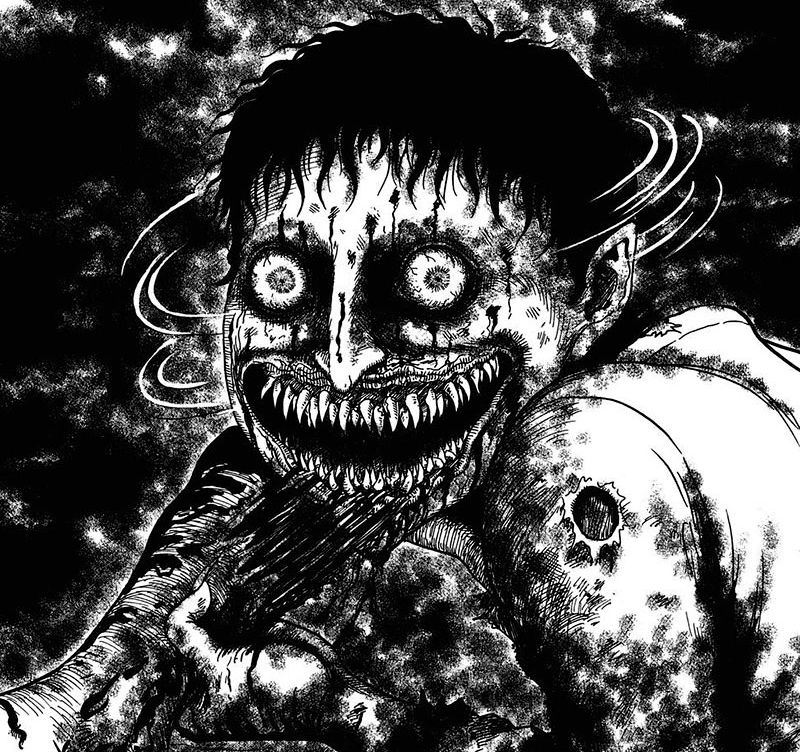
The story features, as the title says, a haunted mansion or better a haunted house.
Our main characters are two young boys who find out about a new haunted house in their town. The of them witness as other people visit the attraction and flee the place scared half to death.
Eventually, the two of them make their way there and get invited by the owner for free.
There are quite a few surprises ahead, not only for our main character but also for our readers who might recognize a few reoccurring characters.
This is another story that features one of Ito’s most unsettling drawings, which you can find above.
21. The Thing That Drifted Ashore
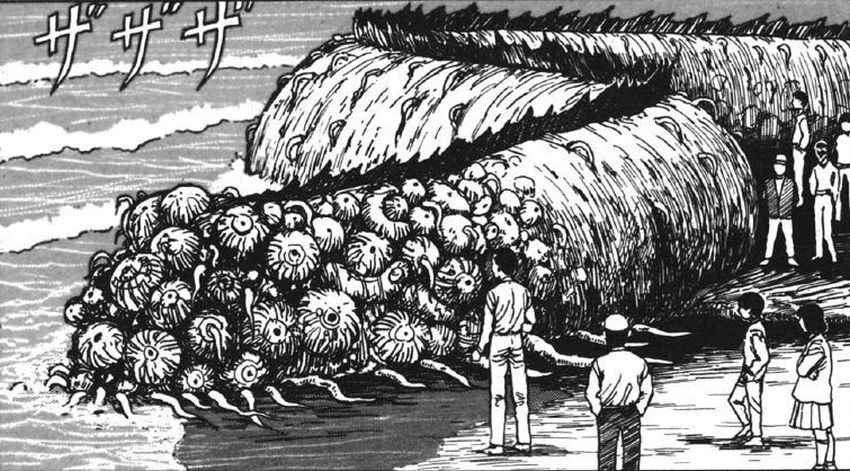
The deep sea is one of the few places on our planet that’s still mostly unknown.
The same could be said about the universe, but it’s huge, infinite by our standards. The ocean however is right here, right next door to some of us, yet we barely know a thing about it. It can be unsettling to think about what horrors lurk down there, in its depths.
The premise of this story by Junji Ito is simple. A horrific deep sea creature is washed ashore. It’s not a whale or anything that was ever seen before. It’s an unknown, disgusting, and almost Lovecraftian creature.
People are driven to the beach in droves, some to see the strange creature, others to figure out what sort of creature it actually is.
As the story progresses another horrific truth is revealed, namely that something is moving inside its body, something that’s still alive.
What makes this Junji Ito story so interesting is the possibility that something like this creature could actually exist somewhere out in the depths of the ocean.
20. The Window Next Door
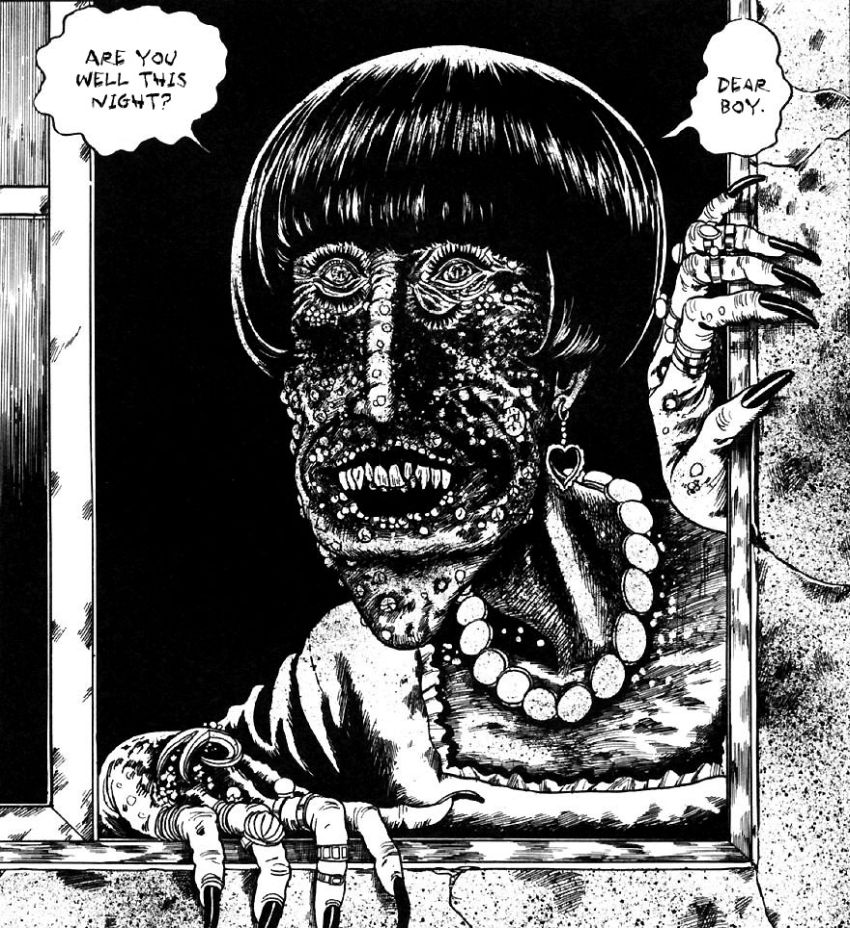
This is another one of Junji Ito’s very short works with a very simple premise.
Hiroshi and his family move into their new home, situated right next to a strange building. Said building has only one window, right opposite Hiroshi’s very own.
The family learns that the building is the home of a strange, secluded lady. When we finally get to see her though we are presented with another iconic one of Junji Ito’s drawings.
It’s this drawing, the details, and the artistic skill displayed that makes this story so special. The rest is almost forgettable, anticlimactic even.
Yet, I can’t help but hold this story in high regard, especially since it inspired my series The Disappearing Alley.
19. Black Paradox

Black Paradox is wild, Black Paradox is weird, and Black Paradox is actually quite interesting.
The story starts with a group of four people who form a suicide pact to end their lives together. Somehow though, our main character Marusou ends up with a group of doppelgangers.
After uncovering what’s happened and after meeting up with the real group, they postpone their attempts and meet again at a later point to go through with it.
From here on, the manga only gets stranger.
Black Paradox is one of Junji Ito’s longer works consisting of six chapters in total. The biggest problem with Black Paradox is the disjointed start. It starts with a suicide pact, but the focus of the series proofs to be about something entirely different.
Still, it features Junji Ito’s typical masterful art and his crazy imagination. For that alone, it would be worth the read. Yet, as weird as the story starts, the better it gets later on.
Overall, Black Paradox is quite an enjoyable experience, and I’d highly recommend it.
18. Glyceride
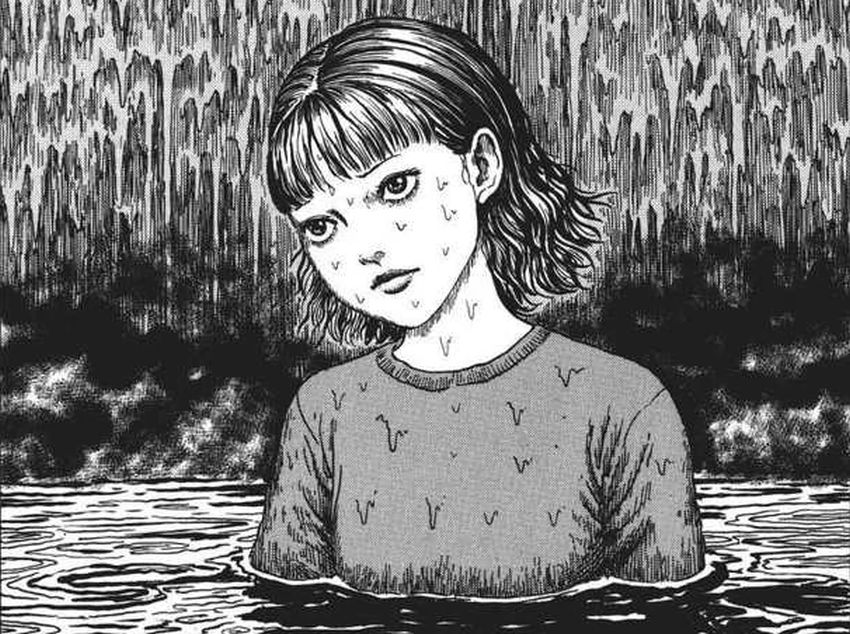
This story, oh god, this story. Many of Junji Ito’s stories feature disgusting images, but this story might be the worst.
It’s the story of a young girl, Yui, who lives with her sadistic older brother and her father above the family’s yakiniku restaurant. Said restaurant is the reason the entire house is coated in thick layers of grease.
Soon enough, her brother hits puberty and develops pimples. Because of the thick greasy air and his habit of drinking oil, his acne gets much, much worse than it usually would. I guess you can tell where things are going.
However, the story isn’t solely about the crater face’s eruption. There are even more sinister things going on at the family restaurant.
An interesting side note, I recently learned that this story stems from Junji Ito’s experience during dental school. When there he was forced to sleep on a dirty, sweaty futon himself.
It’s honestly one of Junji Ito’s most disgusting stories and of course, it features another one of his very popular drawings. Read it, but you’ve been warned.
17. Town Without Streets
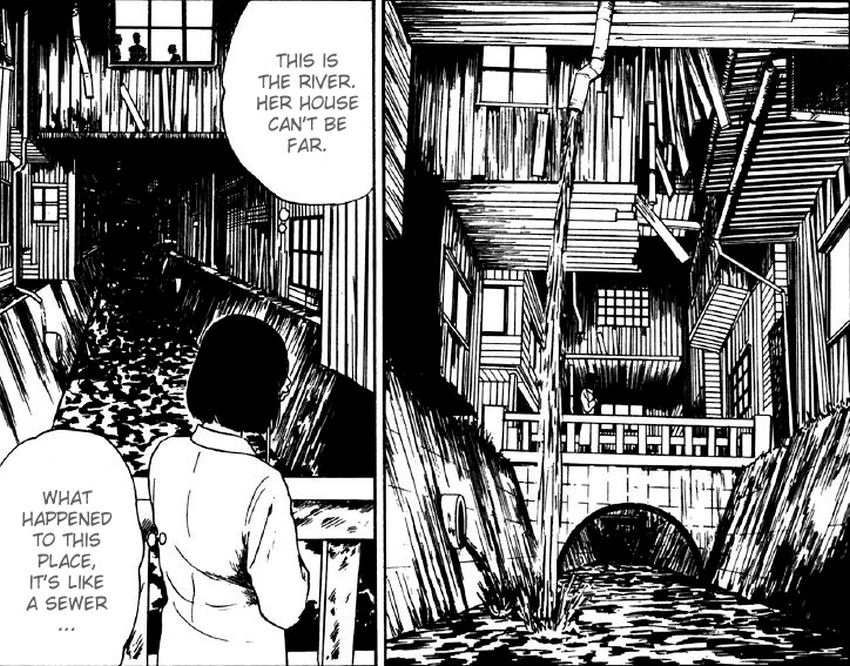
I’ve always been a fan of concepts such as a city within a building. That’s the reason I also enjoy stories that are set in confined or restricted spaces.
This story by Junji Ito begins with Saiko, who’s sick and tired of her family constantly spying on her. So she leaves her family to live with her aunt instead.
She travels to her aunt’s town only to discover that all the streets have been blocked by wooden, make-shift buildings. That’s not the only thing though, the entire town has been boarded up by wooden constructions almost making it a single building.
Out of necessity, the people in this town had to find new passageways. Without streets, the only way to get anywhere was via people’s houses. This eliminated all privacy between the people living in the town.
Even worse there’s this constant feeling in the town that you’re being watched by someone, or… something.
I really enjoyed the bizarre setting of the town and Saiko’s walk through various buildings and different areas of the town.
There’s also a secondary plot happening about a killer appearing in people’s dreams. Yet again, it feels a bit disjointed and doesn’t seem to fit in with the rest of the story.
It’s obvious this story’s focus is the intrusion of privacy and the fear of being watched or being spied on. While I don’t think the dream killer story is necessary, perhaps it signifies yet another intrusion of privacy. Not even your dreams solely belong to you.
Either way, it’s a very interesting story which shows that Junji Ito doesn’t shy away from sometimes including more serious topics in his work.
16. The Bully
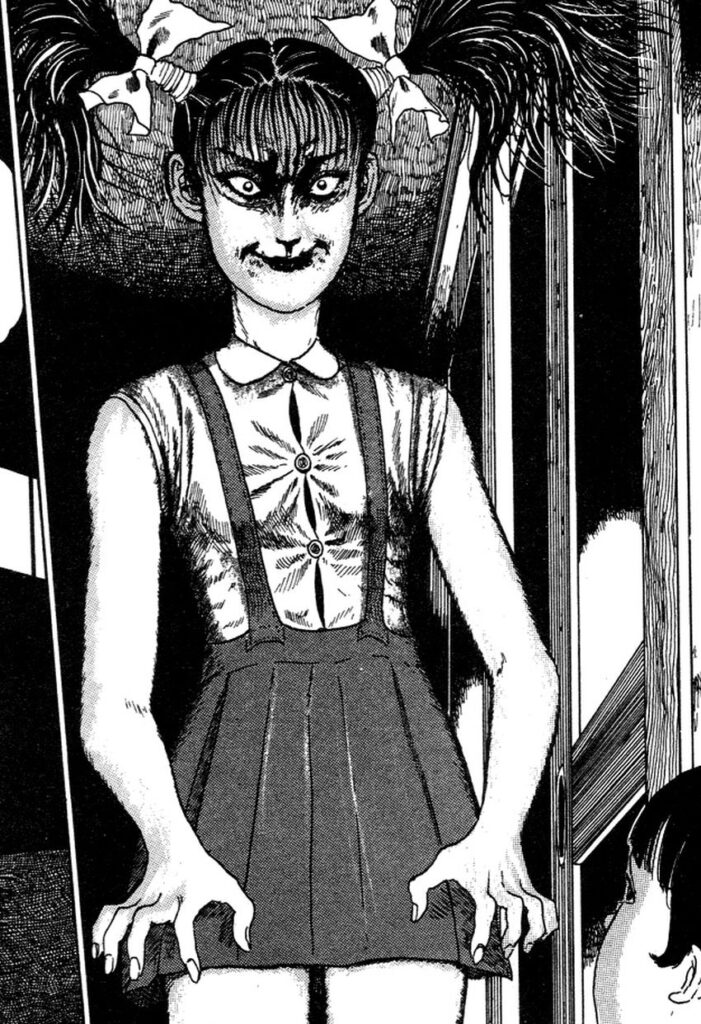
Oh, The Bully, what a story.
Junji Ito’s stories are rarely grounded in reality. They feature monsters, outlandish powers, or supernatural entities. This one here’s a rare exception to the rule.
The Bully is the simple story of a young girl bullying a little boy. When the two of them meet again as adults though, things take a different turn, one for the better.
However, this is a Junji Ito story, so there’s no happy ending here. What makes this story so terrifying is the absence of supernatural forces. This one’s entirely grounded in reality, and it makes it so much worse.
15. The Licking Woman

Imagine a stranger runs up to you and licks your face. That’s the simple premise of this story by Junji Ito.
Miku’s fiancee Tsuyoshi gets licked by a mysterious woman on his way home. Of course, the story isn’t just about the disgust of being licked. No, the Licking Woman’s saliva is dangerous and soon Tusyoshi dies from it.
As time passes more cases related to the Licking Woman are reported and more people are getting hurt.
Miku of vows for revenge and plans to kill the Licking woman. However, there are quite a few surprises ahead for her.
This story has quite a few things to offer. There’s the general disgust of being licked by a stranger and worse, being hurt by it. What makes this story so great is once more Ito’s imagery. The disgusting, bloated, wet tongue, her mouth, her eyes, they almost warp the licking woman into something that’s not even human anymore.
Overall, it’s a great story and I really enjoyed it a lot.
14. Frankenstein
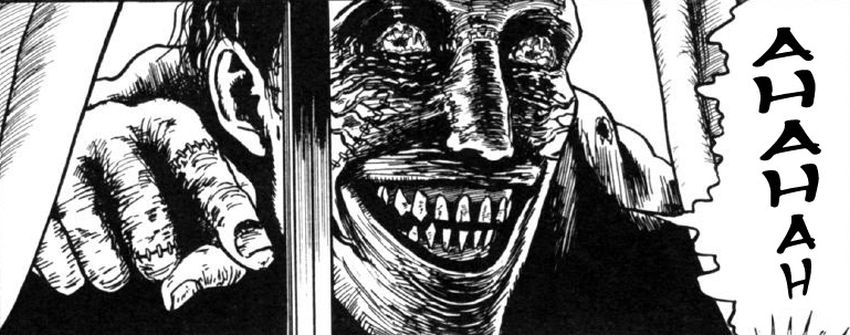
I think most people are familiar with the story of Frankenstein, or have at least heard about it. Having read the original novel and having watched some movie adaptions, I can say that Junji Ito’s adaption is absolutely phenomenal. It might be the best adaption of Shelly’s source material out there.
This volume is frankly said a masterpiece. I’d can highly recommend it to anyone who’s either a fan of Junji Ito’s art style or the original novel by Mary Shelley.
Ito’s strange, unsettling imagery, his over the top way of conveying his characters emotions and his body horror make this an unforgettable experience.
13. Tomie

Tomie is another one of Junji Ito’s reoccurring characters and probably his most popular character. Her stories span three volumes and spawned an entire series of live-action movies.
It’s even more interesting when you consider that Tomie was one of Junji Ito’s earliest works.
Even though the art style in the early chapters of Tomie isn’t as refines as in his later works, you can already get a glimpse of Junji Ito’s crazy imagination.
The story begins with Tomie being a normal, but gorgeous student who’s in an affair with her teacher. In the first chapter, she accidentally dies during a school trip, and the class bands together to hide the fact by cutting her body into pieces and getting rid of her.
The next day, however, Tomie returns and from this point onward things only prove to get stranger. As the stories surrounding Tomie continue, we learn that she’s not a normal person, but an entity with regenerative powers. It doesn’t matter what you do to Tomie, even the tiniest bit of her will regenerate and grow into a new version of herself.
As if that wasn’t enough, Tomie also has an almost supernatural hold upon man. Every man she meets is taken by her, falls in love with her, and eventually grows obsessed with her. This obsession always ends with a descent into madness.
Tomie was the first of Ito’s stories I discovered, and I read all the chapters in one day.
Looking back, the quality of Tomie’s chapters varies. Some are better, some are worse. At times, Junji Ito’s at the top of his game, and some chapters are masterfully done and contain some of the most horrific things he’s ever drawn. However, other chapters can be rather forgetful.
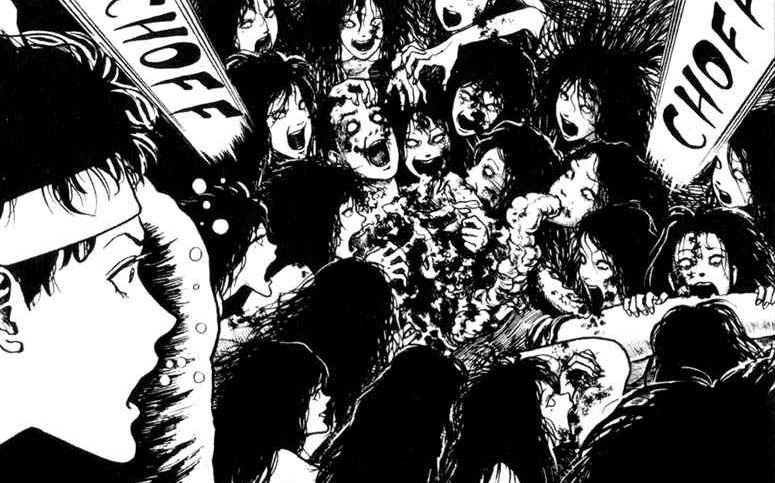
All in all, though, Tomie is definitely worth the read and even at its weakest Tomie is still a very enjoyable read.
12. Oshikiri
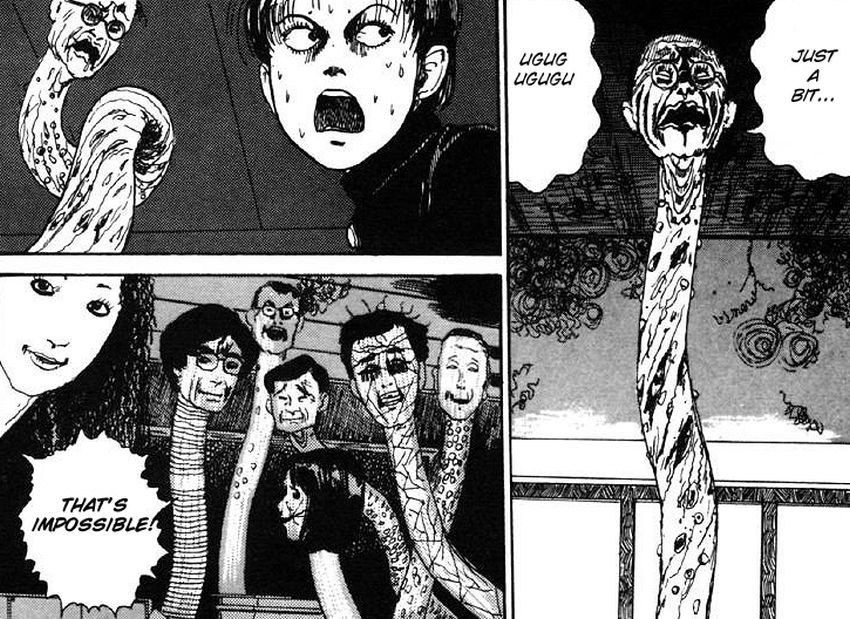
Oshikiri is another reoccurring character and most of his stories are centered on the strange events happening in the mansion he lives in.
I never hear people talk about Oshikiri’s tales, yet I feel that some imagery here is absolutely amazing.
As with some of Ito’s other stories featuring the same character, Oshikiri’s also doesn’t follow a general storyline. Considering the things we learn about his mansion, these stories might not even be related at all.
The main reason I adore these stories is that they feature some of Junji Ito’s greatest imagery and body horror.
The very first story centers on weird hallucinations in which people’s necks grow and distort. A later story features a strange medication that warps people’s appearances into ghastly abominations.
Overall Oshikiri’s stories are very strange, feature an idea I’ve never seen in any other story by Junji Ito, but they are also creative and at times horrifying. They are definitely worth a read and I feel they are truly underrated.
11. Headless Statues
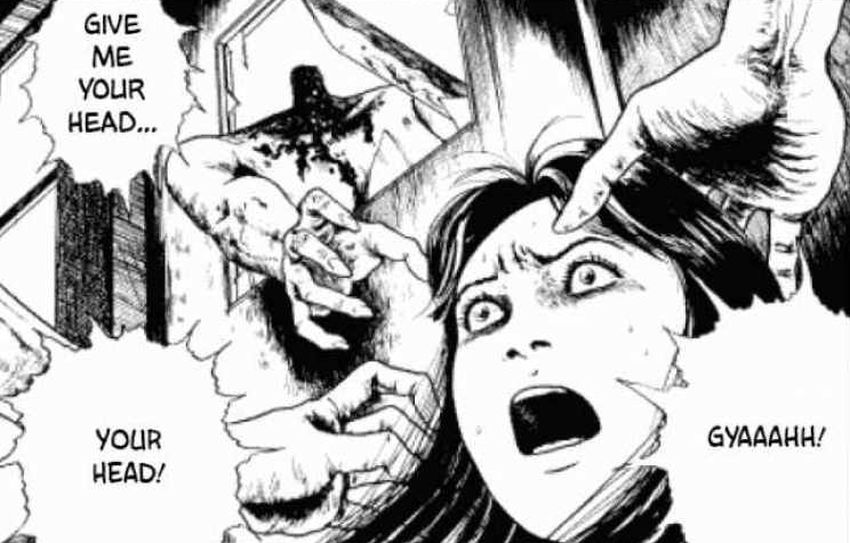
Another one of Ito’s earlier stories, but man do I love this one.
The story introduces us to our main character Rumi, her boyfriend and their teacher Mr. Okabe, who’s an artist specializing in the creation of headless statues.
At the start of the story, Mr. Okabe is tragically murdered. In the days that follow Rumi’s boyfriend Shimada, the last person Mr. Okabe hung out with starts behaving strangely. As the two of them return to the place of the crime, the teacher’s art room, things quickly spiral out of control in typical fashion for Junji Ito.
As with many other stories by Junji Ito, one can assume from the title alone what will happen. What I like so much about this one is the execution and the ghastly art. We get distorted faces and Junji Ito’s typical, nightmarish and brutal imagery.
I also think Headless Statues has one of the best, most terrifying ending panels in all of Ito’s stories.
10. Fashion Model

Another fan favorite story by Junji Ito and oh is it deserved.
Miss Fuchi, the titular fashion model, makes us uneasy the moment we first see her on the pages of a fashion magazine.
The main character, Iwasaki, is so horrified by her he suffers from nightmares because of her outlandish appearance.
As the story progresses, Iwasaki eventually gets over his fears of Miss Fuchi. That is until he and his fellow students search for a female lead for their newest movie project.
The moment we see Miss Fuchi in person, we can already tell that there’s something amiss about her. She’s not only tall, but she’s also almost gigantic, her face is too long and her eyes don’t look like those of a normal human being. No, there’s something very wrong about this… person.
On the way to the project we get a first glimpse of how unnatural and monstrous Miss Fuchi is and from there, things only escalate further.
Miss Fuch is definitely one of Junji Ito’s most popular and iconic creations. The story itself might be rather conventional for Junji Ito. There’s no supernatural phenomenon happening, there are no distortions of the human body or mind, no, this is just a story about a monster.
But what a monster Miss Fuchi is. She will stay on your mind, just like she did on Iwasaki’s.
9. Lovesick Dead
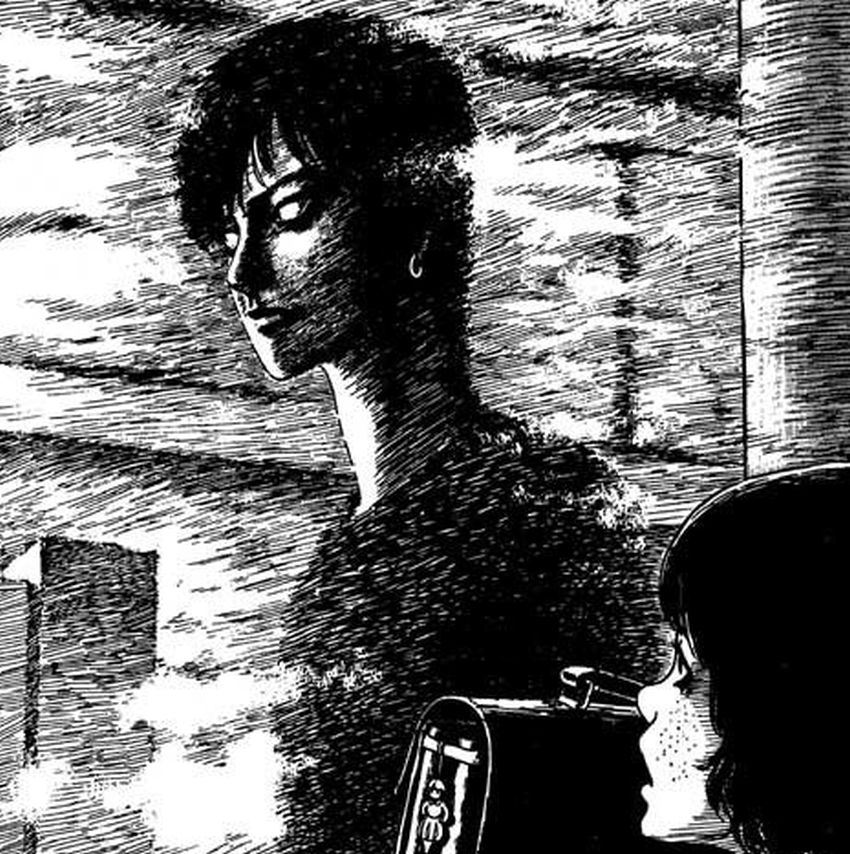
This is another one of the very first Junji Ito stories I read, and it always stayed on my mind. What puts it here, in the top ten, is as much nostalgia as anything else.
Lovesick Dead is another one of Junji Ito’s longer works, spanning five chapters in total.
The story’s set in Nanchou-Shi a town enshrouded by thick layers of fog. It’s definitely a great scenario for a horror story.
Right away we are introduced to the concept of intersection fortune-telling, a practice at the core of the story. It’s simple. People wait at an intersection for someone to pass by and ask them to tell their fortune.
Our main character Ryuusuke is returning home after him and his family left the town many years ago. As the story progresses a strange character called the Intersection’s Pretty Boy starts wandering the streets of the town. Whoever encounters him during intersection fortune-telling will only get an ill fortune, with dire consequences.
It’s a typical Junji Ito story. People act irrational, go insane, or get obsessed to the point of mutilating and even killing themselves.
There are some parts of the story that are a bit disjointed and don’t seem to fit in too with the overall narrative. It’s a problem we often encounter in Junji Ito’s longer works. Yet, does it really matter? People read Junji Ito’s works mostly for the horrifying imagery and his crazy ideas.
Overall, Lovesick Dead is a great read, and it features a lot of unsettling and at times quite gory art. What I love especially is the mysterious setting of a town perpetually enshrouded by thick, heavy fog.
8. Long Dream
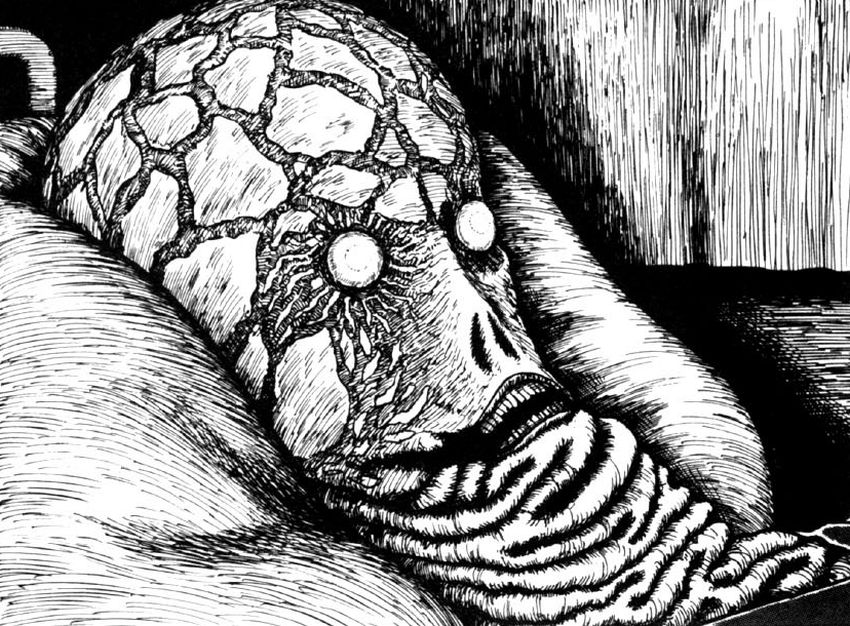
Long Dream is another super story by Junji Ito with a concept that’s equal parts interesting and terrifying.
Mami, a young woman with a dire diagnosis, is terribly afraid of death. What makes it even worse is that she talks about death himself visiting her hospital room.
However, it’s not death, it’s another patient named Tetsuro Mukoda. The man suffers from a very strange condition that causes him to have the titular long dreams, dreams that last for days, weeks, months, and even entire lifetimes.
Long Dream is especially scary because of the idea of getting lost in your dreams and forgetting both the real world and who you really are.
It’s definitely one of Ito’s most creative and original stories. It also comes with its fair share of body horror, as the people suffering from long dreams slowly transform, degrade, and get warped into something terrible and alien-looking.
The most interesting part about this story is that there are no monsters here, no antagonistic powers, no, there are only dreams.
7. Army of One
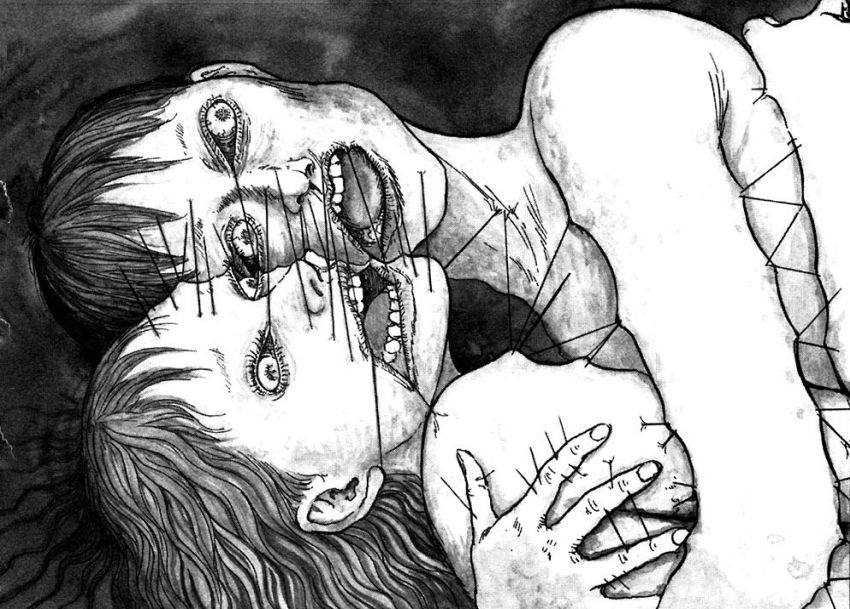
This is another great Junji Ito story and one of my absolute favorites.
Army of One was merely a bonus chapter to Hellstar Remina, but in my opinion, it’s much better than all of Remina combined.
What makes Army of One stand out among Junji Ito’s other stories is that starts as more of a thriller than a horror story. People go missing and soon after their stitched-together corpses are found.
At first, it’s only two people at once, but soon more and more people go missing and get strung together into nightmarish, public displays all over the city. It’s at this point that not only the characters in the story but also we as the readers realize that this can’t possibly be the work of a single person.
Even worse, there doesn’t seem to be any hint of struggle, and no bodily harm was done to the victims before being stitched together.
What makes this story so interesting is that it changes one of horror’s predominant rules: strength in numbers. If you want to live through any horrific scenario, you stay together. Not so in Army of One, here the rule is reversed. The first to die aren’t those who are alone, no, it’s those who get together and mingle with others.
Truly one of Junji Ito’s best works.
6. Lingering Farewell
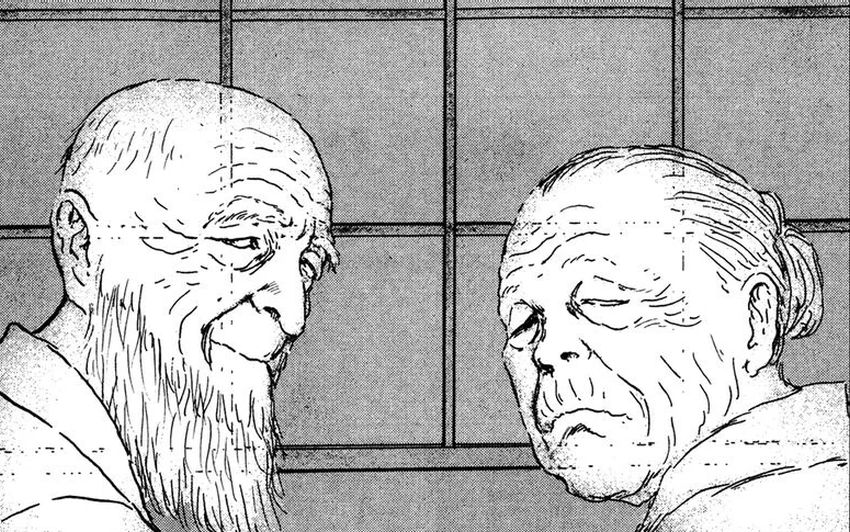
Another story that sticks out among Junji Ito’s body of work. It’s not one of the terrifying and horrific tales we’re so used to, it’s rather a sad little tale.
The story starts with Akiko, a young woman always plagued by the fear of her father dying.
The story progresses and Akiko marries Makoto and joins the Tokura household. There’s one peculiarity about the Tokura family though, a special practice. When a relative dies, the members of the family get together and perform a ritual which will create an afterimage of the person.
Throughout the story learn more about afterimages, their nature and the characters.
Everything about this story is great and, to me, it holds a very special place among Junji Ito’s many works.
5. The Enigma of the Amigara Fault
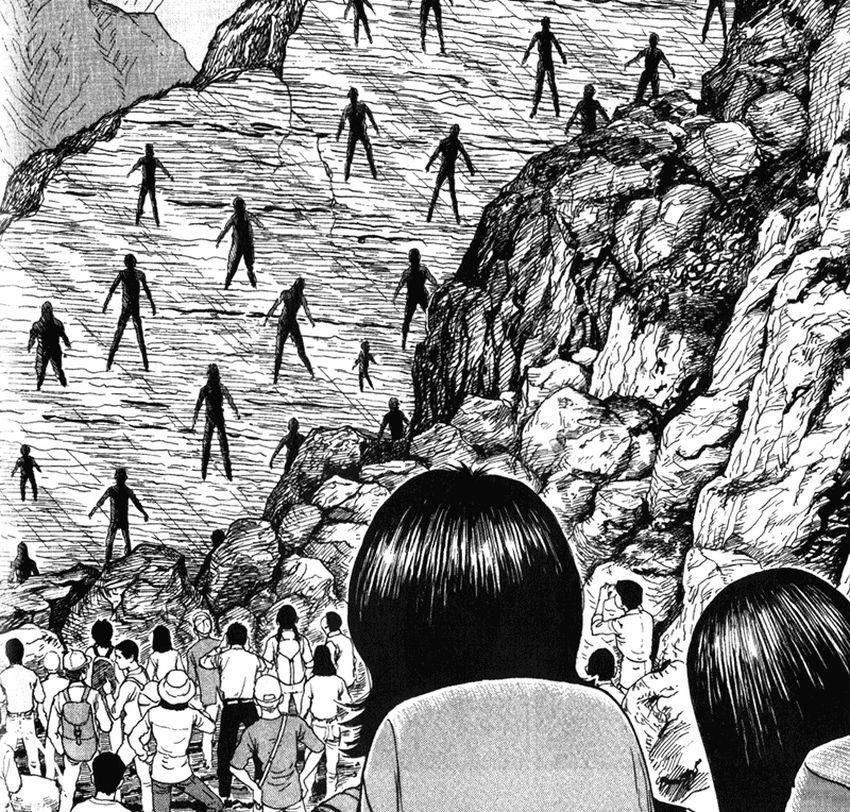
We enter the top five with another one of Junji Ito’s most popular stories and definitely one of his masterpieces. The story was first translated on 4chan back in 2006 and went viral instantly.
The story’s premise is simple. People-shaped holes appear on the side of an earthquake fault line, and soon people from all over Japan flock to the location.
Most of those watching the event on TV became restless and were driven by a strange desire to visit the location themselves.
Our main characters are an unnamed young man and a young woman named Yoshida. Both share the strange feeling and are driven to the Amigara Faults.
As the story continues we see other people, who came in search of their hole and soon enough we see them enter them.
At the core of the story is the compulsive urge of people to understand the unexplainable. That itch inside their minds that questions why those holes are there, how they were created, and why there exists one with their exact shape.
Even worse, there seems to be no explanation for the event. We never find out what those holes are and why they exist.
What makes this story by Junji Ito so great is the mixture of claustrophobic horror, the fear of the unknown and the strange allusions of the impossible.
The Enigma of the Amigara Faults is truly an absolute masterpiece.
4. Layers of Fear
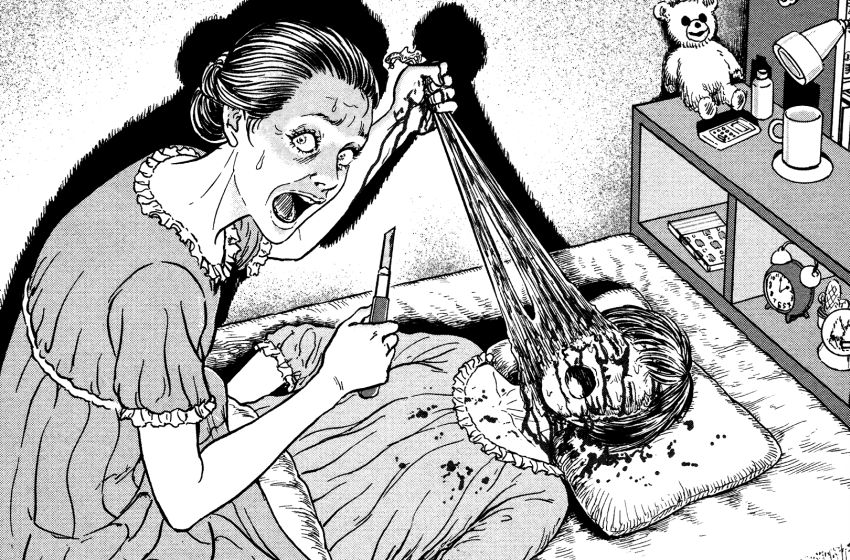
Layers of Fear is one of Junji Ito’s more recent work, and definitely my absolute favorite among them. It brings forth one of his craziest ideas and supports it with breathtakingly horrific imagery.
This story is absolutely wide. When I first read it, I could only read it in its original Japanese version. Even though I hadn’t understood a thing, I couldn’t help but stare at my screen in awe.
The story starts with a professor uncovering the grave of a child that was created by stacking layers upon one another.
After this event we move forward to the present time, years after the father’s death his family is on the way to a ceremony.
On the way there, the family has a car accident and one daughter, Remi, gets part of her face sliced off.
Instead of suffering a terrible wound as one would expect, it’s revealed that under her skin is another layer of skin. From here on out, the story only gets crazier and crazier.
The story doesn’t focus on this premise alone. As with many other stories by Junji Ito, it’s multilayered in its horror. There’s also Remi’s mother, an older woman obsessed with her daughter’s childhood.
What makes this story so amazing is not only the outlandish idea it puts forth, but once more Junji Ito’s imagery, which is at the top of its game here.
Layers of Fear is amazing and I can’t recommend it highly enough to anyone interested in Junji Ito.
3. My Dear Ancestors
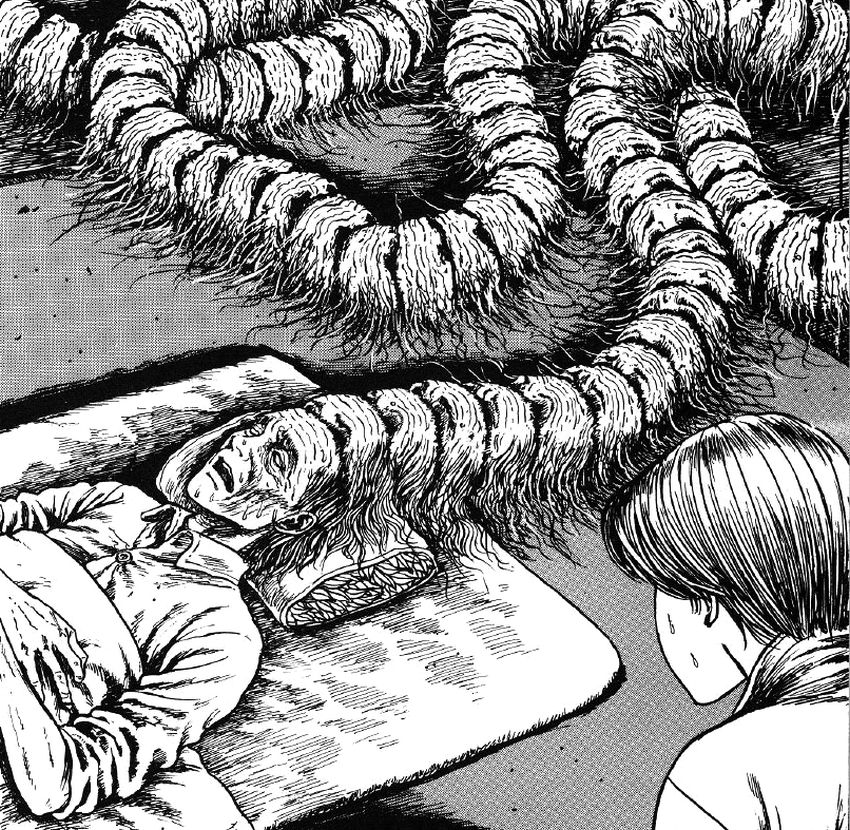
This story, this freaking story.
Risa, a young woman, suffers from temporary amnesia and is plagued by nightmares of a giant, caterpillar-like creature.
Her boyfriend Shuichi tries to help her and brings her to his home to meet his father.
This is where things get strange. Her father enters the room in a very weird, almost spider-like fashion.
From this point on, the story takes a quick turn to the utterly bizarre as the reason for both the father’s weird behavior and Remi’s amnesia are revealed.
My Dear Ancestors is undoubtedly one of Ito’s most bizarre and grotesque stories.
2. Uzumaki

Uzumaki is without a doubt an absolute masterpiece and Junji Ito’s magnum opus.
Manga can be a strange genre. There are many works out there and I’ve read my fair share of bizarre manga, but none was as weird as Junji Ito’s Uzumaki.
It’s a three-volume long series set in the small Japanese coastal town of Kurouzu-cho which is infested by spirals.
Everything in this story, everything in the imagery, is linked to spirals. Even the horrific events that take place in town all happen because of spirals or are related to them.
Spiral shapes appear all over town, things take on the form of spirals, and soon enough even the townsfolk are obsessed with them.
This leads to some of Junji Ito’s greatest and most outlandish imagery. People are warped, changed, and transformed into various spiral-like shapes.
And this brings us to Junji Ito’s most iconic drawing.
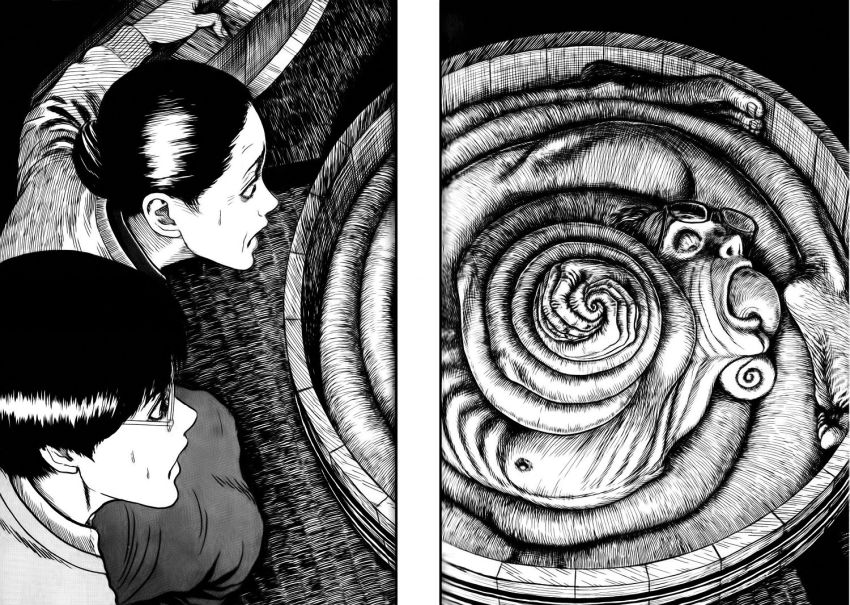
This image is not at the climax of the story, no, it’s merely the first chapter and from then on things only get stranger and more horrible. Nothing in Kurouzu-cho is safe from the curse of the spiral. People transform into snails, lovers entangle each other like snakes and even hair develops a life of its own.
What sells Uzumaki is without a doubt Junji Ito’s terrifying and horrifying art, and in Uzumaki, he’s at his absolute best. His simple, clean black-and-white style, his precise craftsmanship brings forth the horrors that re happening in Kurouzu-cho in every last horrifying detail.
Most of Uzumaki’s story is episodic. The first two volumes feel almost like a collection of short stories that all feature the same setting and the same reoccurring characters.
In my opinion, Uzumaki is at its weakest in the last volume when Junji Ito brings everything together and drives the narration to its end.
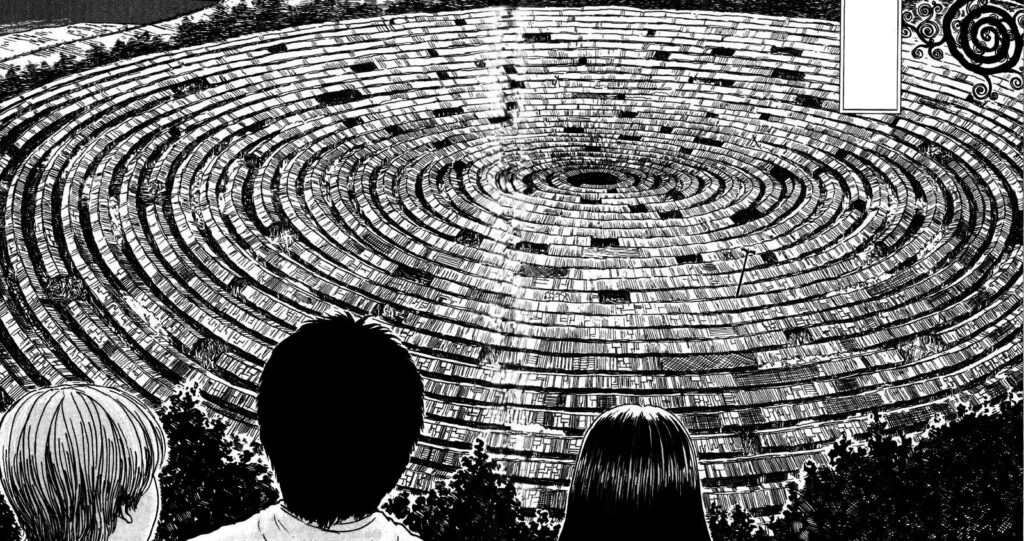
It’s a satisfying conclusion to a fantastic piece of weird fiction, but once more I feel Ito’s at his best when things are left open and when we don’t find out what exactly is going on.
What makes Uzumaki stand out so much among a plethora of other horror works is the lack of a feasible antagonist. There are no monsters to fight, no killers to run from. No, there’s only the spiral, a concept that lingers of the town in the form of an omnipresent curse.
Reading Uzumaki for the first time is an utterly surreal and absolutely horrifying experience, but one that’s without a doubt satisfying to anyone interested in horror.
There’s even a new anime adaption of Uzumaki coming and it looks absolutely fantastic. You can find the trailer right here.
1. Hanging Balloons
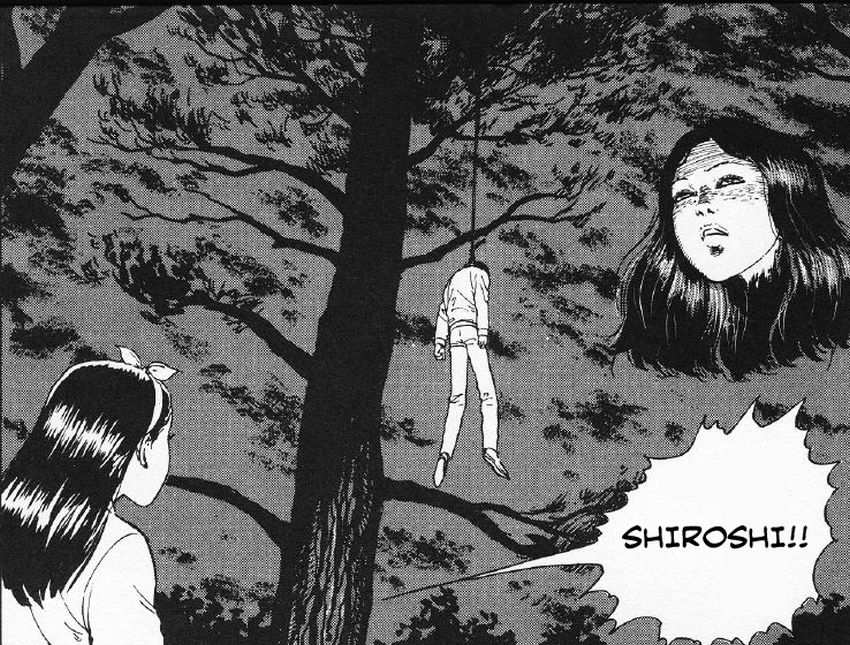
As I said I’ve been reading Junji Ito’s works for years and recently I came to appreciate Hanging Balloons just for how good it is. It’s, in my opinion, one of Ito’s best stories ever.
It’s bizarre, absurd, surreal, and downright creepy.
The story is long when compared to Junji Ito’s other one-shots. It starts slowly, with the suicide of Kazuko’s best friend, Terumi. Her body was found outside her apartment, dangling from a nose.
Soon enough though, Terumi’s boyfriend Shiroishi and other people start to see Terumi’s ghost lingering around town. What makes it even stranger, it’s just her head and a giant version of it.
At first, people try to explain it by mass hysteria and similar syndromes until the first picture of the floating head surfaces.
One night a troubled Shiroishi calls Kazuko. He’s been following Terium’s ghost and wants to prove to her it does truly exist. It’s then that Kazuko witnesses the true horror that’s happening in the story: The Hanging Balloons.
The sheer idea of a giant balloon with a replica of your face on it is creepy enough. This balloon coming after you to hang you with its noose makes this story so utterly nightmarish.
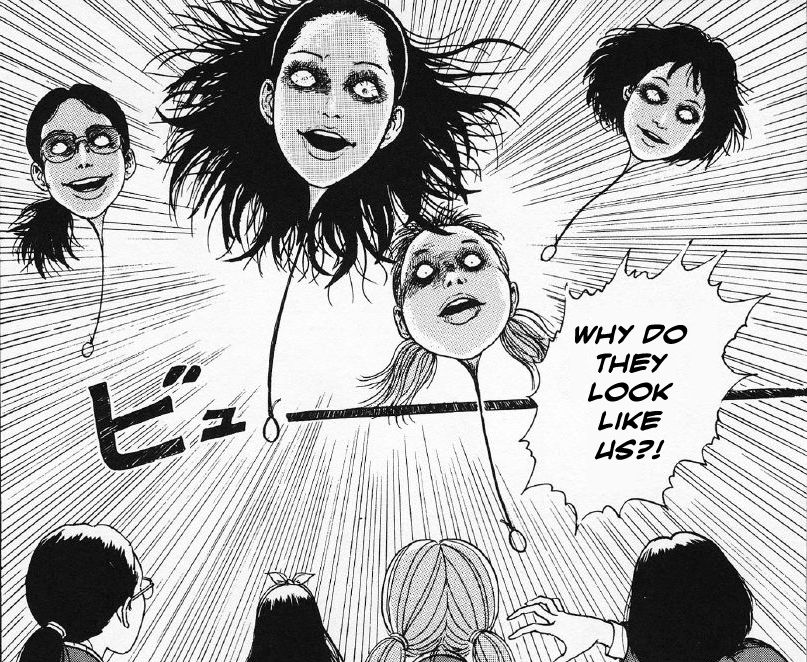
The great thing about this story is the horror and the scenario. It’s probably the most bizarre and surreal idea of an apocalypse ever put forth in fiction.
Sure, there have been many types of an apocalypse featured in fiction, but here it’s no monsters or zombies, it’s your own face stalking and eventually killing you. Even worse, you can’t destroy the balloon for you will share the same fate it does.
In terms of story-telling, I love the slow start of the story and the way it makes you believe it will be a ghost story.
Another fact that makes this story work so great is that similar to others like Army of One or The Enigma of the Amigara Faults, we never find out anything. We don’t learn where those heads came from or their true nature. No, it all stays an utter mystery. We’re thrown into the story, witness it with Kazuko, and at the end the mystery’s left intact.
And who could forget that terrible last panel?
To me, Hanging Balloons is an absolute masterpiece of bizarre and surreal storytelling and my favorite Junji Ito story of all time.
If you’re interested in Ito’s works, many of his short stories have been published for Western Audiences in the collections Shiver, Fragments of Horror and Smashed.
Many of his longer works are available as well, such as Uzumaki, Tomie and Gyo.
All of his works are available on Viz Media.




I love Junji Ito’s work! They are so unique and terrifying to me and I love it! I would love to know if there are any female horror manga writers/artists out there. (I’m sure there are but I sadly don’t hear about them as much)
Unfortunately I don’t know about many myself. The only one I can think of is Kaori Yuki who created the series Count Cain or Godchild which is a gothic manga. I only read part of it, but I thought it was quite interesting at times, definitely worth checking it out!
Although, one more thing that I must admit is that even though I greatly admire Ito and love his work, some of this stuff focus on certain misogynistic stereotypes that are not that appreciated. Like in some stories where the female character is sadly the only girl in her friend group and anytime another female character appears, she immediately becomes jealous of her, which I really hate to see. I’m definitely thinking of ones like the Seashore story from Mimi’s Ghost Stories, among a few others of his. I just wish he wouldn’t depict female characters in those ways.
I can see your point about female characters. I’m not sure if it’s Ito’s intention though. He always overdraws emotions and obsessions like jealousy. I feel he isn’t trying to depict real characters, but specifically those who are easily jealous, easily fall in love or easily grow obsessed with certain things. Again though, I can see your point.